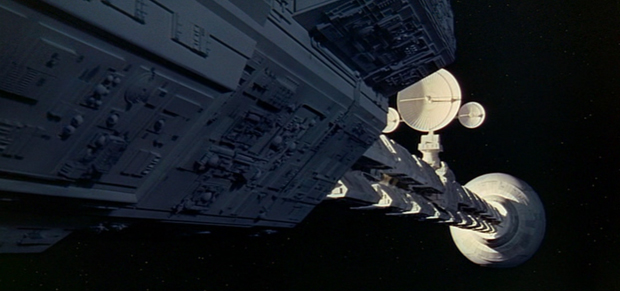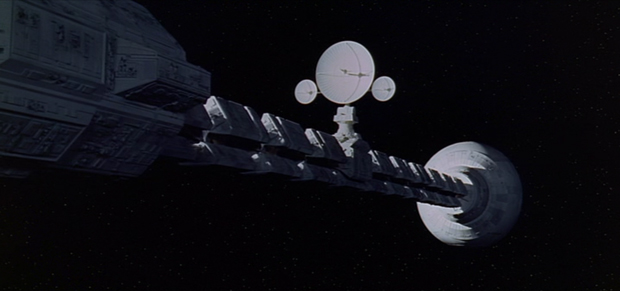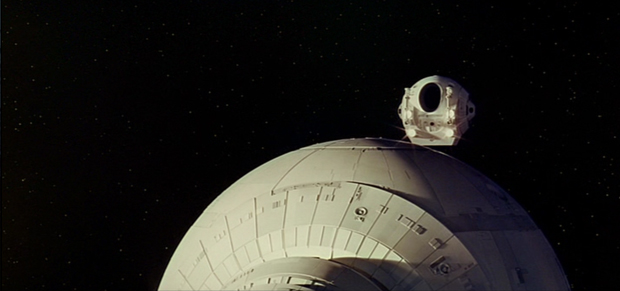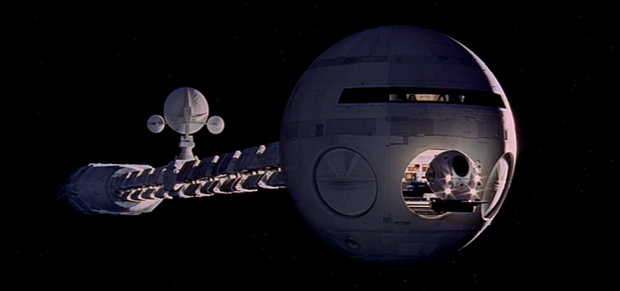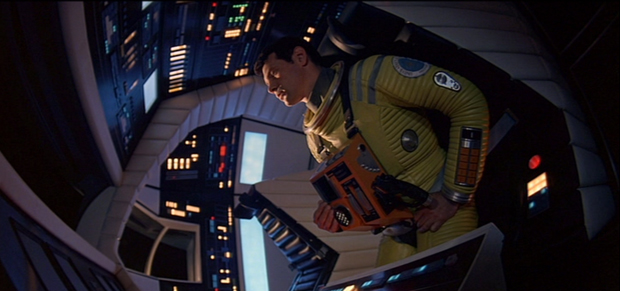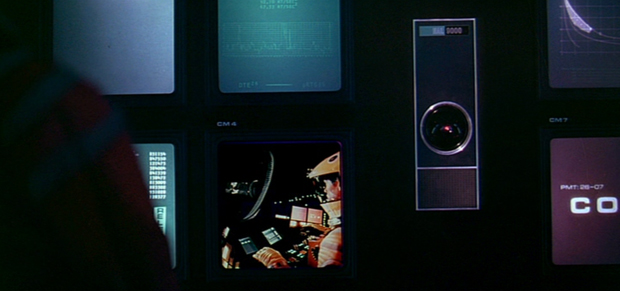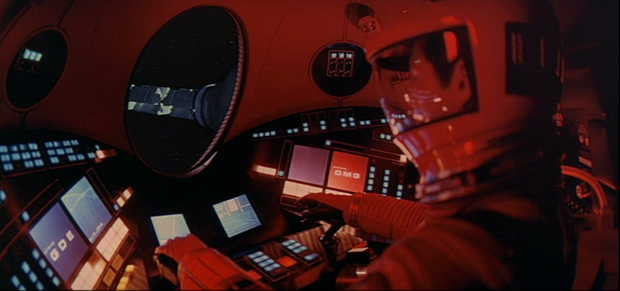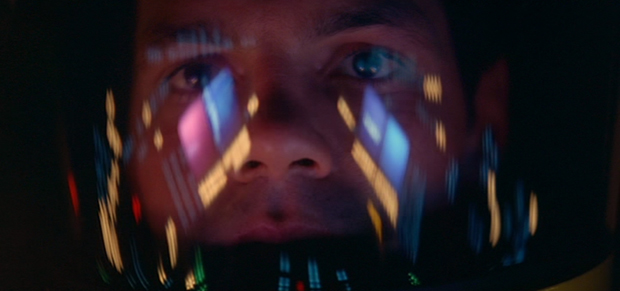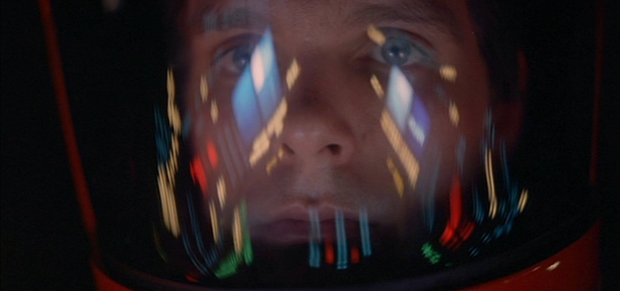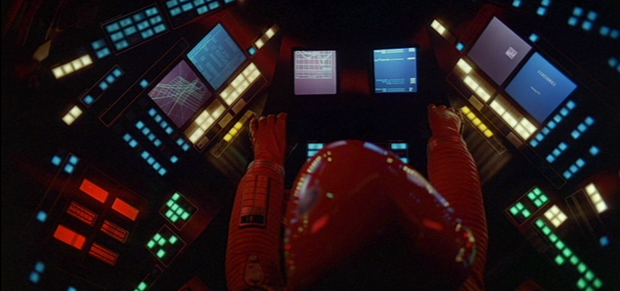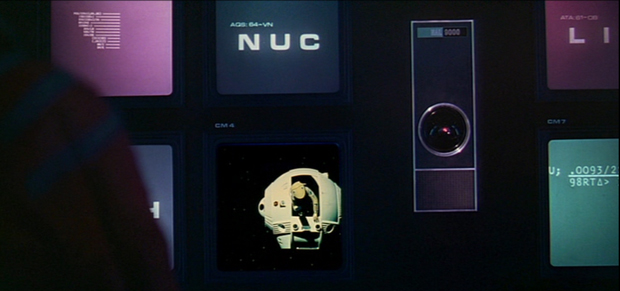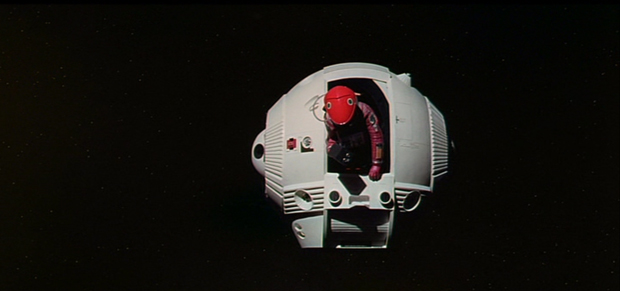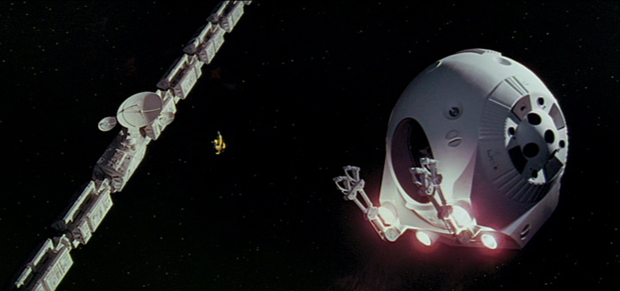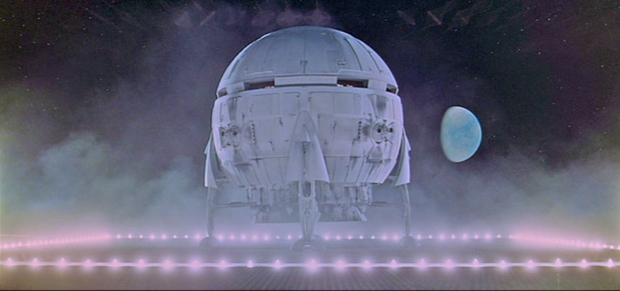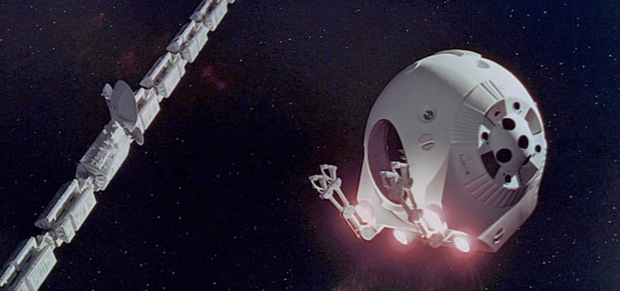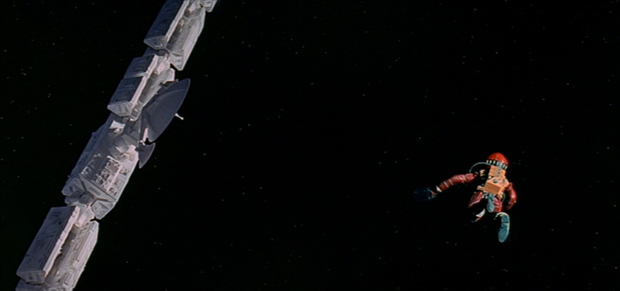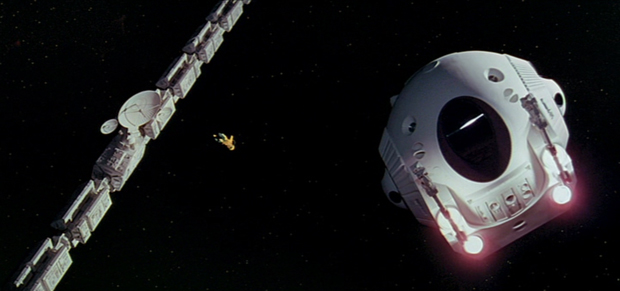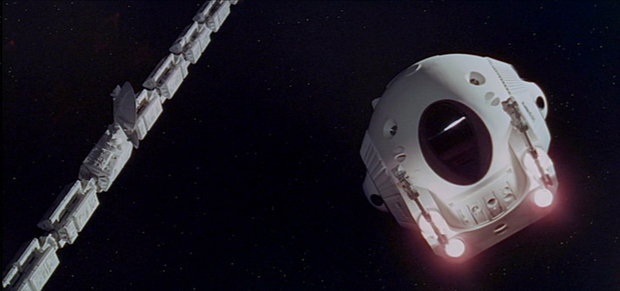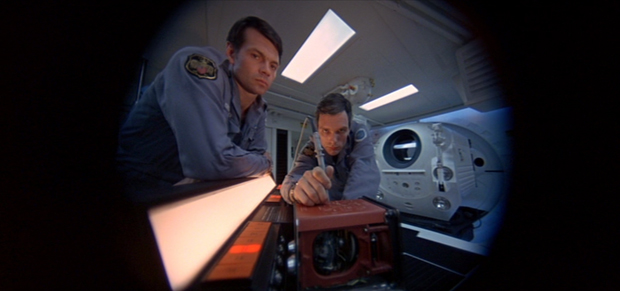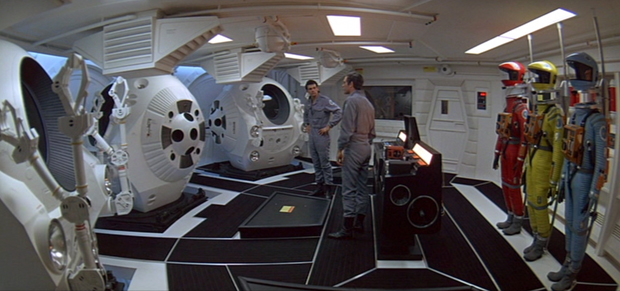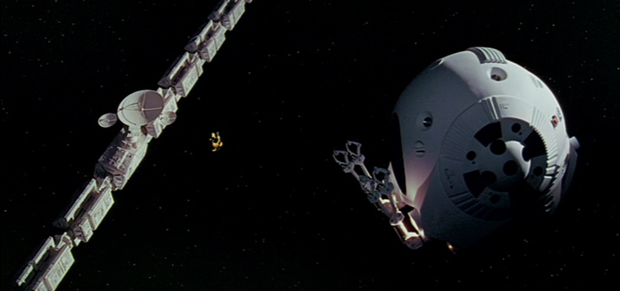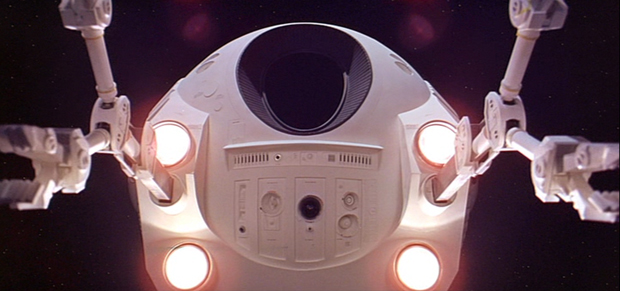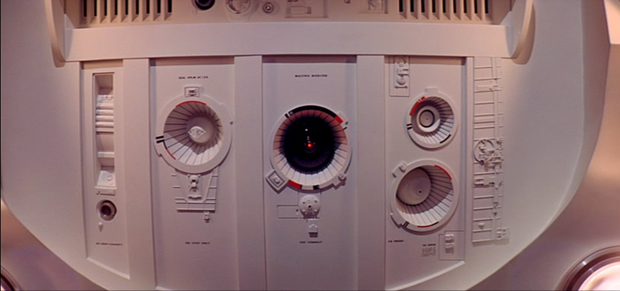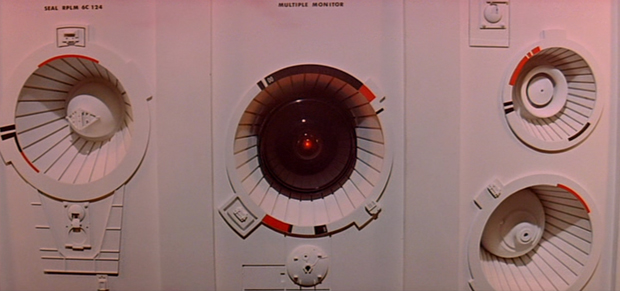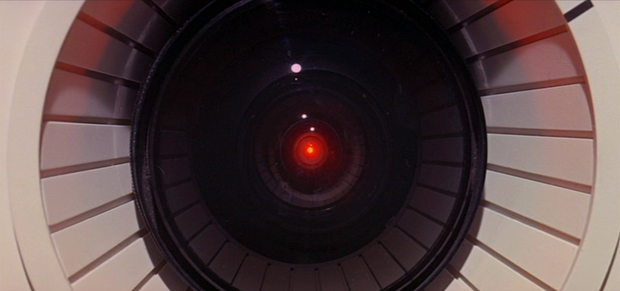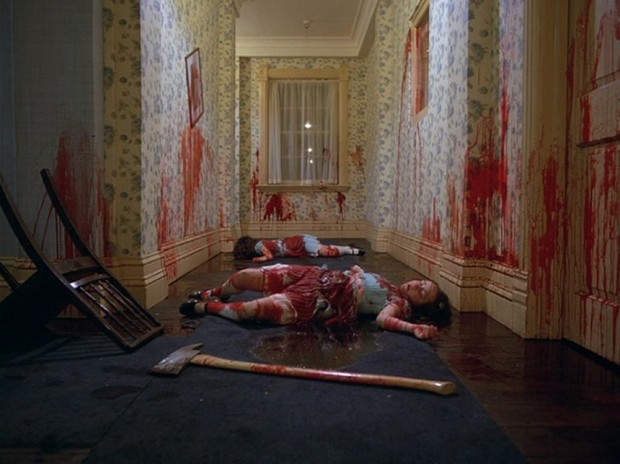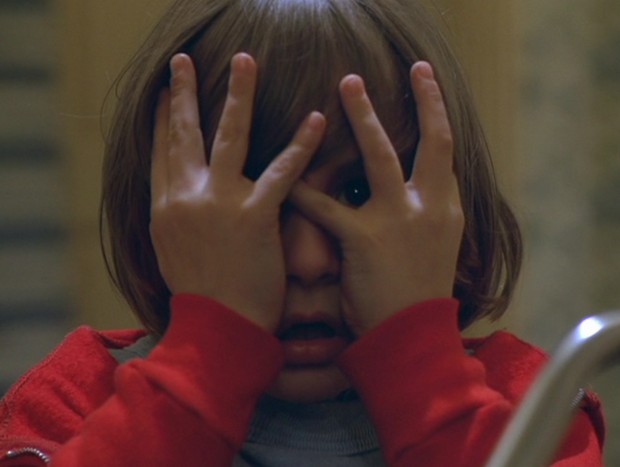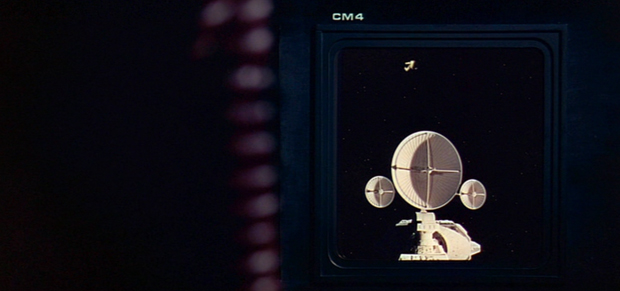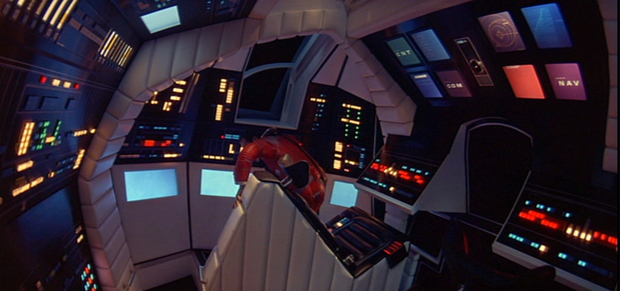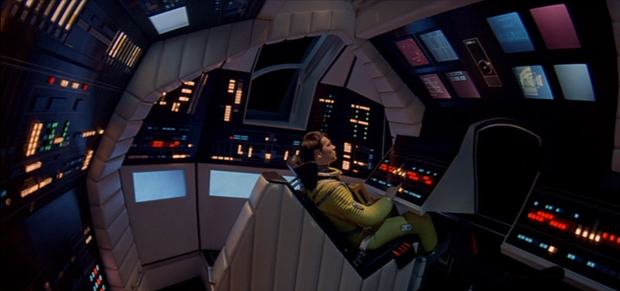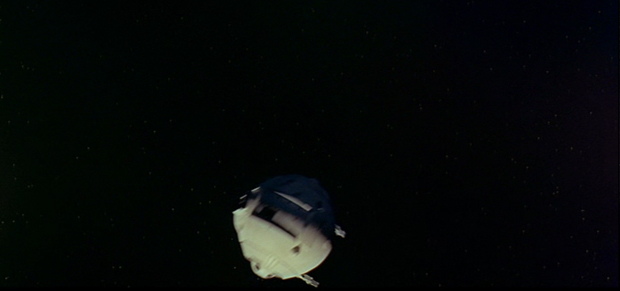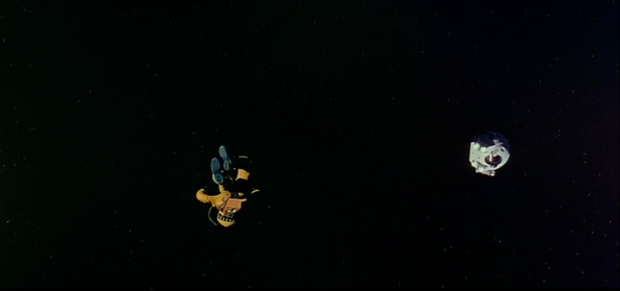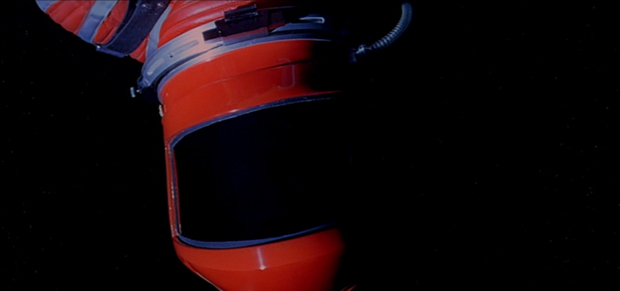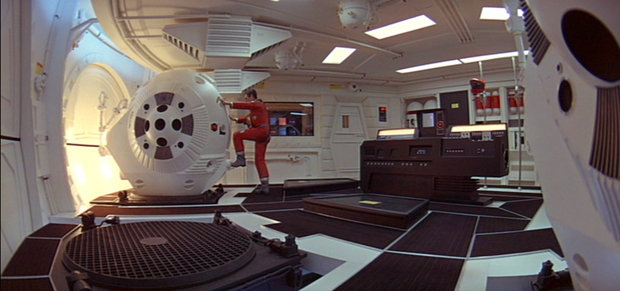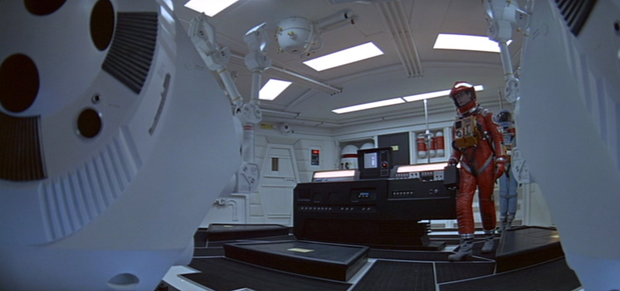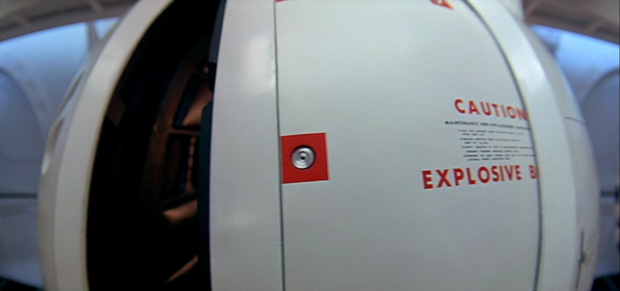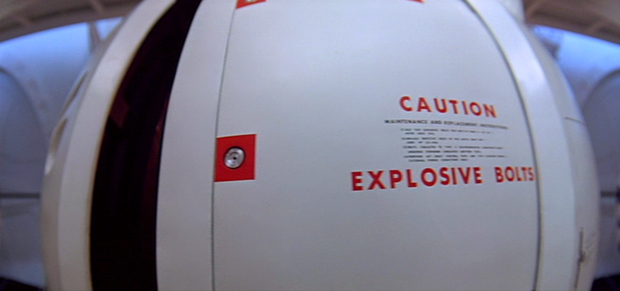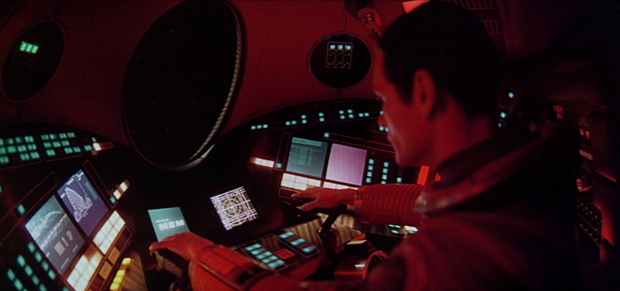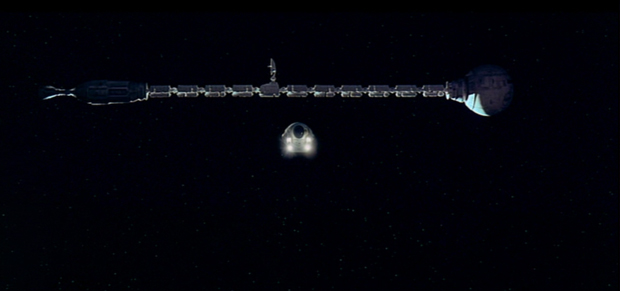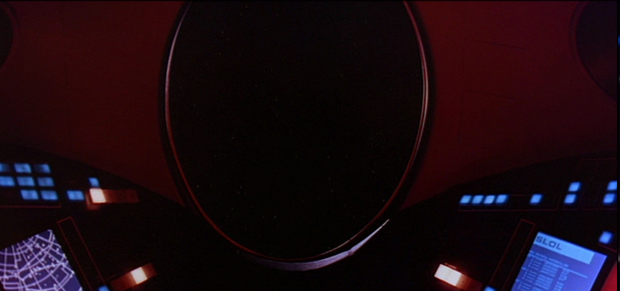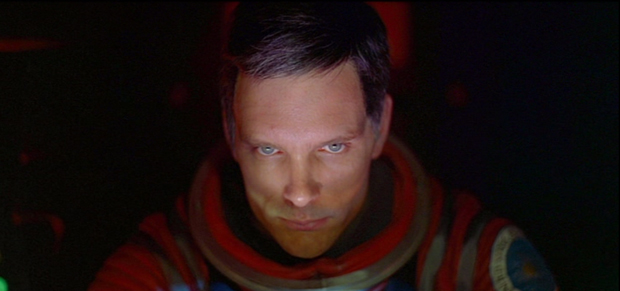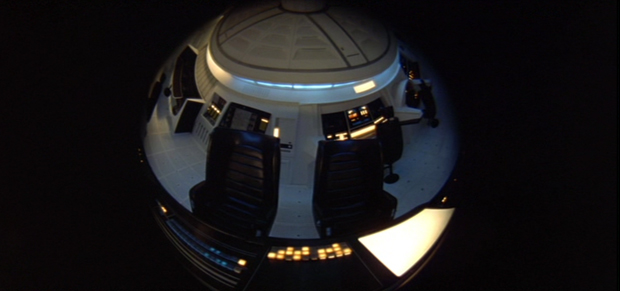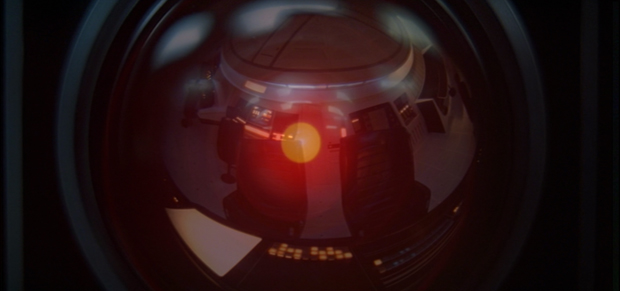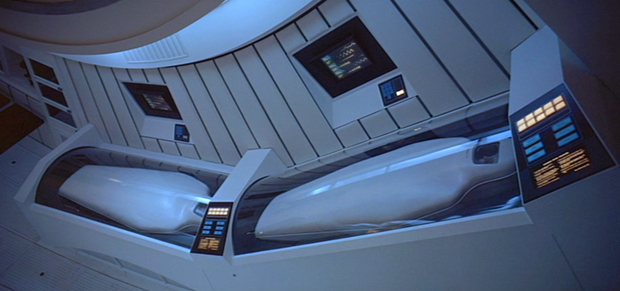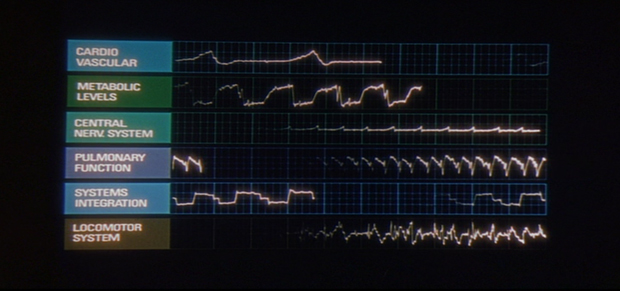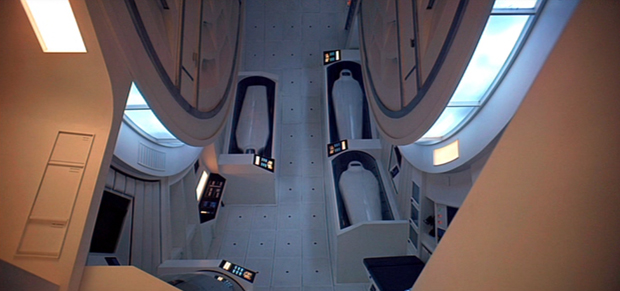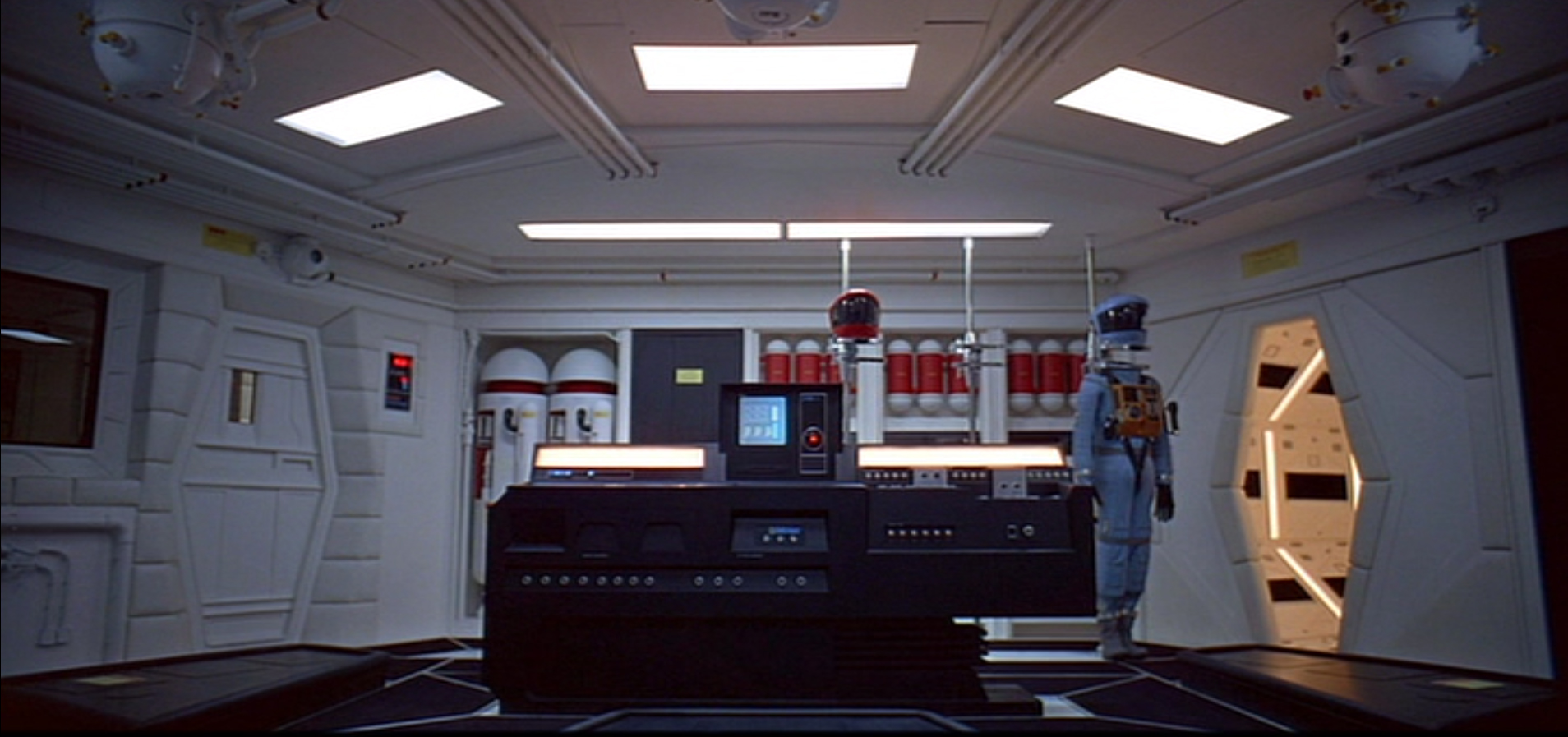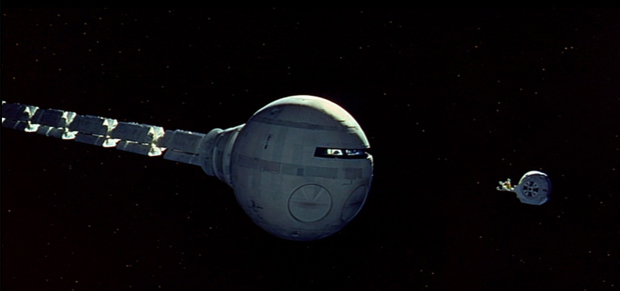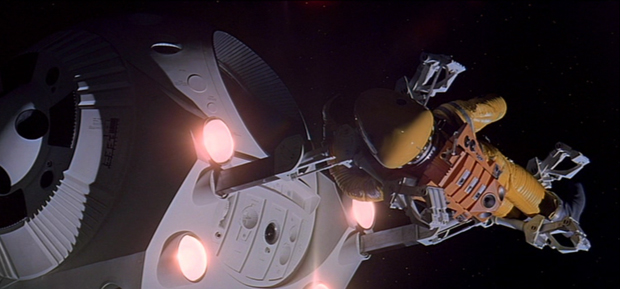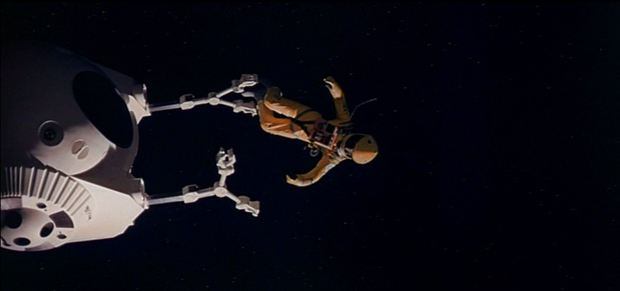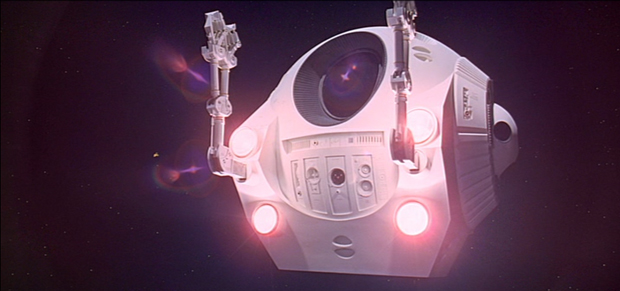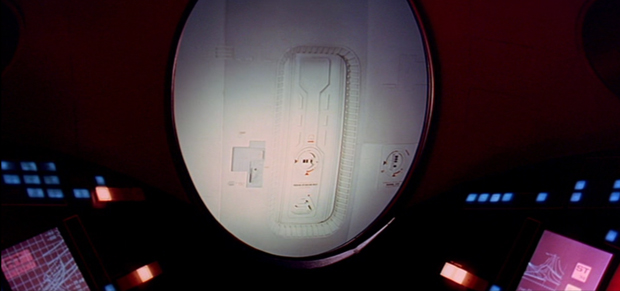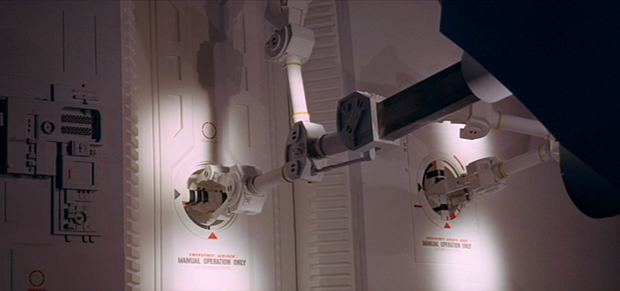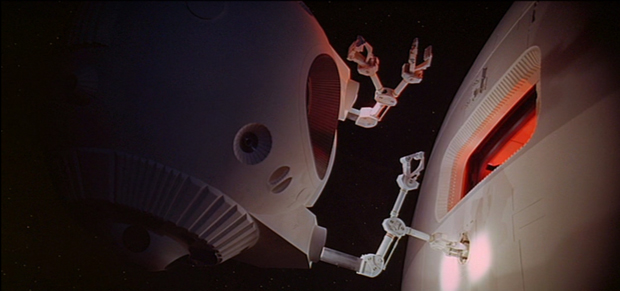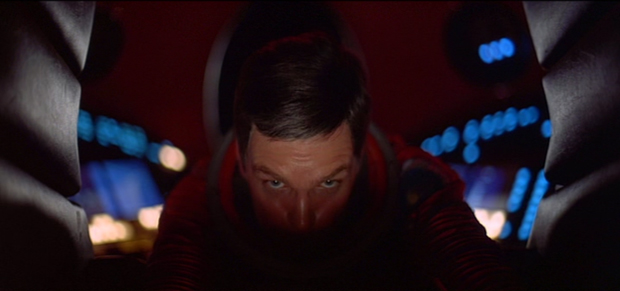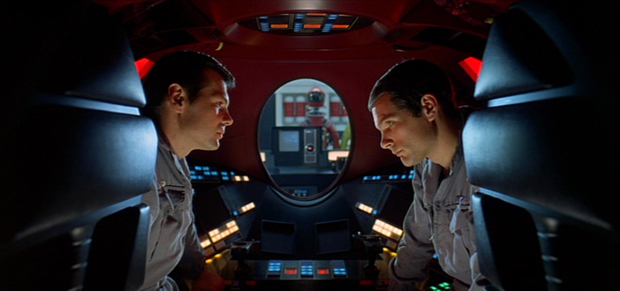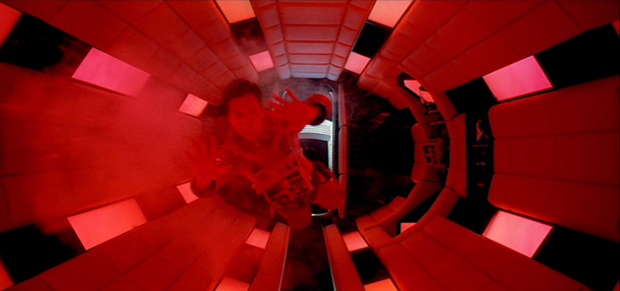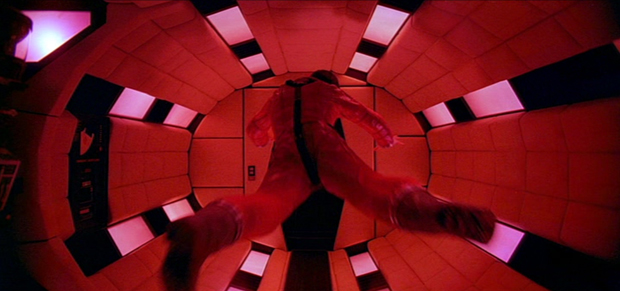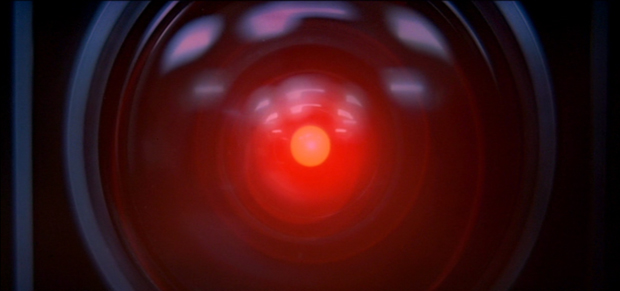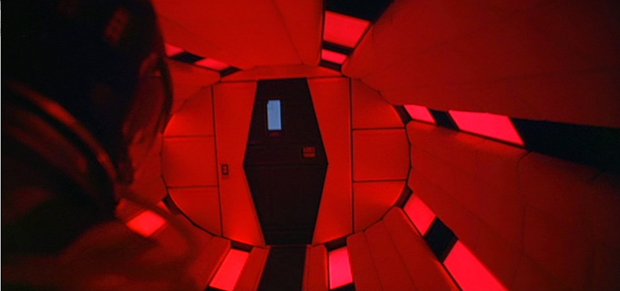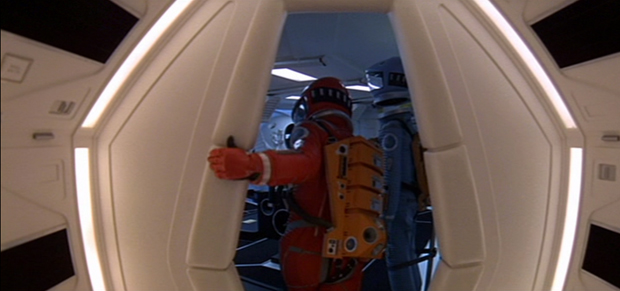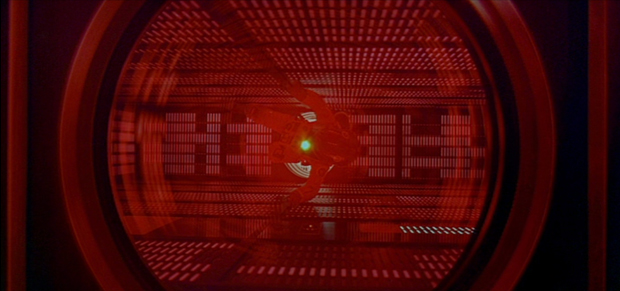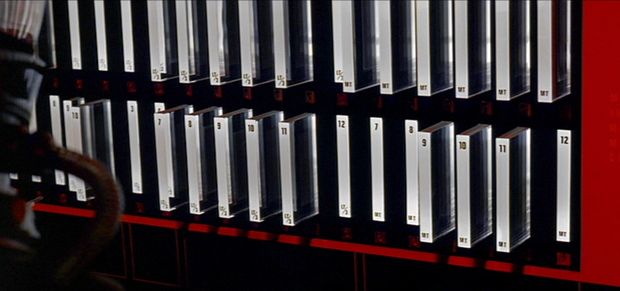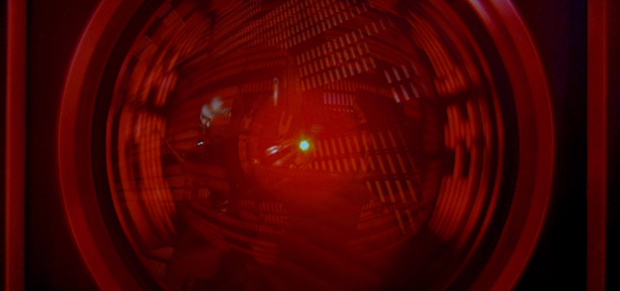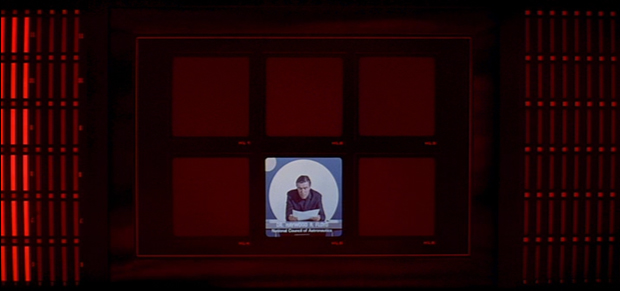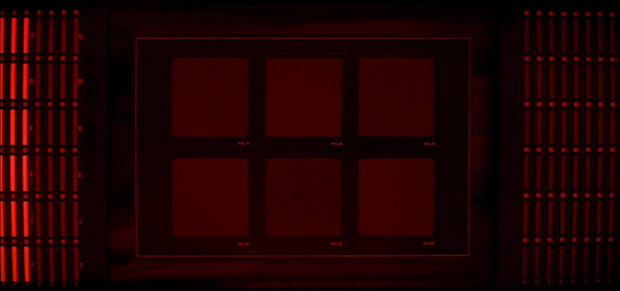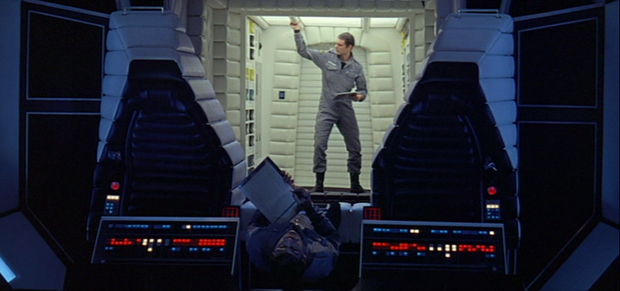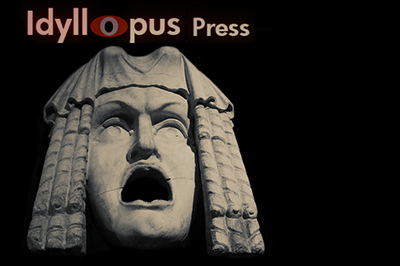STANLEY KUBRICK'S FILM

Go to TOC for this film ( (which has also a statement on purpose and manner of analysis and a disclaimer as to caveat emptor and my knowing anything authoritatively, which I do not, but I do try to not know earnestly, with some discretion, and considerable thought).
PART FOUR
TOC and Supplemental Posts | Part 1 | Part 2 | Part 3 | Part 4 | Part 5 | Films Home
LINKS TO SECTIONS OF THE ANALYSIS ON THIS PAGE:
Some subjects/subheadings covered:
Atmospheres, Shot 361
This part is a doubling of Dave's EVA by Frank with doublings of shots that appear slightly different. Comparison to the same reduplication of a journey by Alex the new man in A Clockwork Orange and Bill after his experience at Somerton in Eyes Wide Shut. Deja vu and anamnesis. HAL's oracle and predetermination. The assurance of the fruition of the oracle by the elimination of free agents. HAL as a conscious entity, but he is without breath.
Lather, Rinse, Poole's Space Walk. Shots 362 through 380
Repeat. Comparison of repeated/duplicated shots in Dave's mission and Frank's EVA. Shot 368 and the impossibility of Dave viewing this shot of Frank. This is a reduplication of the shot of Dave leaving the pod but the audience viewed that, whereas here Dave is viewing Frank leaving the pod, and it is absolutely impossible for him to view it. (I love this. It's so much fun.) The Little Things. The bar of light in the pod window. The 3 lights in the CU of Pod's eye and the 3 lights in the window behind the slain girls in The Shining. Danny's single eye and HAL's eye. The continued zoom of HAL's eye eventually shows the eye with the occlusion that is supposedly back on the ship, not the eye of HAL on this pod outside the ship.
The Show Down, Shots 381 through 511
Dave Pursues Poole in Absolutely the Opposite Direction From Which He'd Disappeared. Frank's hurtling away is reminiscent of the astroid that flies past in Dave's EVA. Frank spun off to the "left" of Discovery One. Dave flies off to the "right" side. The Dreamless Sleep of the Hibernators. Again, the Eye of HAL Which is Not There. The emotional power in Dave's release of Frank's body to the void. Comparing shot 482 with shot 291--so similar as to be identical but are not. Compare with Wendy's running down the red hall in The Shining and the emergence of a new connecting hall not observed before. The color pink in this scene and the pink in the Space Station flight attendant scenes. "See you on the way back." 486 and the new view of HAL's eye never seen before. Why is the prerecorded message staticky, cutting in and out?
Comparing the Death of Poole with the Assault of Danny in The Shining
Perceptual and Conceptual Knowledge
THE ORACLE UNFOLDS
ATMOSPHERES
SKIP ALL THIS AND TAKE ME TO THE TL;DR WRAP-UP AT THE END OF THE PAGE.
00 INTERMISSION (1:27:20)
Quick fade out at 1:27:43 of Intermission type. The sound that had accompanied also fades out and music enters, Gyorgy Ligeti's "Atmospheres". The music fades out completely at 1:29:55.
361 Exterior Discovery One. (1:30:04)
We hear the heavy breathing which signals the astronaut in his atmospheric suit.
One will feel they've seen this shot before, that it is the same as the first shot in the third section, but instead it is a bit different. Below is part of shot 223.
Kubrick leads off with shot 361 reduplicating shots 223 and 256 from the third section (in which we're introduced to Discovery One), and so it will be for the first part of this section, every single shot will be a replay of one that we've had before.
As I noted at the end of section three, this is comparable to the time that is post Ludovico cinema in A Clockwork Orange, the second section of the film wherein Alex revisits past circumstances with different effect as a person who is unable to express aggression. He returns to his home and finds he has no place there, pushed out by a lodger who is like a new son. He encounters the old man he'd beaten up and the tables are turned so that he is attacked by the man and his friends. He meets up again with two of his gang who have become police and also rough him up. Finally, he makes his way back to HOME and Alexander, not recognizing at first that this was the place of his attack on Alexander and his wife. His repeat performance of "Singing in the Rain" gives away his identity to Alexander.
This section, with its repeat of Bowman's EVA, by Poole, is comparable also to the post Somerton section in Eyes Wide Shut in which Bill attempts to seek out Nick at the night club, returns to the costume shop, finds his way back to Somerton, and attempts to visit again the prostitute. The majority of Bill's adventures occur in one set of streets that are only minimally changed to give the impression of different areas of the neighborhood, an impression which fails under closer examination and we realize it is all the same several streets. Kubrick's changes were slight in order to communicate the deja vu sense of the maze. We had the same in The Shining with its literal maze and deja vu events centered on Danny's premonitions, Jack's statement on how everything at the Overlook was familiar to him, the role of the caretaker consuming his personality, and then at the end his aspect appears in an old photo that doesn't appear until the very last shot.
These repetitions and reversals are so important to Kubrick philosophically that in the Opening and Closing Day sections of The Shining he has the Torrance VW approach The Overlook, unbenknownst to the audience, from either side of the Continental Divide on the Going-to-the-Sun road in Glacier National Park. (I describe this in the Opening section and also in a separate series of posts.) Within that drive and its reverse aspect we have a discreet horizontal flip without Kubrick physically flipping the landscape or a scene as he actually does numerous times in 2001, the first example being in the Dawn of Man section when the monolith appears, this followed in section two with the numerous reversals of clockwise to counter-clockwise, and many more flip horizontals had in section three.
In The Shining, the deja vu effect, these minor eternal returns and anamnesis events were Jack's and Danny's. But they were created also for the audience with the manner in which the hotel was unfolded, and the audience waiting for the events of Danny's vision to be reduplicated. In 2001, with Poole's EVA we have the same.
Bound up in all this is the idea of the oracle and destiny as versus freedom of will. What is an oracle and the idea of destiny, pre-determinism, a mechanistic universe, but this same deja vu and remembrance. The eternal return. The oracle in The Shining was the seemingly inescapable re-enactment of the madness of the caretaker who, through loyalty to the established design, is doomed to this deja vu and the fulfillment of the oracle. The oracle in Eyes Wide Shut is set up with the invitation for Bill to visit the end of the rainbow, and on the far end of the movie Bill contends with the mystery of Amanda's "bound to happen" drug overdose and death, whether it was accidental or an event purposefully arranged, which ultimately is proposed as being part of a broader, universal pre-determinism. Jack's "All work and no play makes Jack a dull boy" is the same as "The World Tonight" that duplicated itself over and over and over again on Frank's pad's screen prior the playing of the interview with Dave, Poole and Bowman. Jack appears to be locked into the eternal return, though the movie is ambiguous at the end as to how the escape of Wendy and Danny may re-invent this for him either on a personal or trans-personal level, Jack not only being an individual in the story but an archetypal agency.
HAL's oracle concerning the failure of the AE35 is largely forgotten in this section by the audience. The AE35, whether or not it would have failed, becomes for them a moot point with the murder of Poole. HAL's prognostication is remembered afterward and much is made over the perhaps error in HAL's forecast and his "breaking down", the computer becoming the equivalent of a mentally unstable human. And this is set up as a focus point for us. But there's more at stake here than that, for HAL is, again, the representation of the oracle, of pre-determination, the caretaker who is committed to his duty in ensuring the oracle comes to fruition, ensuring submission to an overarching plan. Danny may seem as a free agent, but in The Shining Danny was the one he is the one who broadcasts the oracle to the audience in the first place, what is compelled to transpire.
It isn't just Danny who shines the oracle. It is Tony, Danny having inquired of Tony why he doesn't want to go to the hotel.
If one thinks about it, the strangulation of Danny is much like the murder of Poole in that we're dealing with asphyxiation, a withdrawal of breath. In A Clockwork Orange the sphinx makes a decided appearance, the creature of the story of Oedipus, which is all about his inability to escape the oracle. The sphinx would kill, by strangulation, those unable to answer her riddle. Oedipus vanquished the creature, but he couldn't escape fate. The unraveling, torn yarn of Danny's Apollo rocket sweater, after he is choked, is conspicuous, it reminds of the unravelling hours spoken of in the Gold Room sign, it would remind of Ariadne's clew, but if we look back to 2001 we may also see in the torn yarn of the sweater a reference to Poole's air hose torn loose. Co-incident with Danny's strangulation, Tony emerges and Danny is described as absent, gone. It is only after Danny writes the foretold REDRUM on the door and mechanically chants it, waking his mother as Jack begins his attack on the apartment, that Danny finally appears to re-emerge and become "himself" again.
HAL is supposed to be a mathematically and logically precise machine, his actions not warped by emotion, so we align HAL with the mechanistic direction and pre-determinism of the cosmos with his pure dedication to logic unimpeded by feelings. But what of factors of environment and experience, which may make it so that HAL's twin, on earth, will not compute as HAL does out in space.
We have with HAL, his super intelligence, the adamancy of his inability to fail, what could be conceived of as a kind of intersection of god and man, the ruthless math that guides the universe being programmed with the ability to mimic emotion, a kind of chaos aspect, and eventually HAL appears to feel emotion as he voices fear. We even find that he is programmed to be duplicitous.
If we return to the beginning of the film, the hominid, thoroughly unlike HAL in its wildness, is also completely subject to the design of the cosmos, of nature, but it also has developed the fear that comes with self-awareness, individuation, then after a confrontation with the unnatural craftsmanship of the Promethean grace of the monolith develops the ability to craft tools and rebel against nature, creating free will. The perplexity of HAL is that it too is a tool, a descendant of the bone thrown into the air by Moonwatcher. It is a tool that is asked if it is aware that it is a tool, and as a tool is dependent on the humans who fashioned it.
There are many arguments and counter-arguments to be made concerning HAL. For every argument there is a counter-argument, and these ceaseless arguments and counter-arguments and the inability to escape this dualism is hard-coded in the film, just as with all of Kubrick's films, and is a reason no one can analyze them purely by logic or by psychology and attempt to come up with final resolutions, any absolute answers. The conflict of destiny and free will, of arguments and counter-arguments, is part of the mystery of the snake eating its own tail that Kubrick contrives in his puzzle scenarios.
There is no escaping the question of machine versus free will and Kubrick explores this in every one of his films.
As we enter this section, Kubrick's soundtrack becomes greatly concerned with the sound of the astronaut's breath in the atmospheric suit, which becomes music for the film and also expressed in Kubrick's use of Lygeti's "Atmospheres" during the intermission.
Something that HAL can't do is breathe.
From the Online Etymology Dictionary:
atmosphere (n.) 1630s, atmosphaera (modern form from 1670s), from Modern Latin atmosphaera, from atmo-, comb. form of Greek atmos "vapor, steam" + spharia "sphere" (see sphere). Greek atmos is from PIE *awet-mo-, from root *wet- "to blow, inspire, spiritually arouse" (see wood (adj.)). First used in English in connection with the Moon, which, as it turns out, practically doesn't have one.
It is observed in the solary eclipses, that there is sometimes a great trepidation about the body of the moon, from which we may likewise argue an atmosphaera, since we cannot well conceive what so probable a cause there should be of such an appearance as this, Quod radii solares a vaporibus lunam ambitntibus fuerint intercisi, that the sun-beams were broken and refracted by the vapours that encompassed the moon. [Rev. John Wilkins, "Discovery of New World or Discourse tending to prove that it probable there may be another World in the Moon," 1638]
To spiritually arouse. First used in relation to the idea of discovering in the moon a new world. Both of these are significant in respect of 2001, as well as Lygeti's structure of "Atmospheres" and use of counterpoint.
Kubrick has the sound score as it is for a reason, and much of it is silence versus breath.
HAL self-defines as a "conscious entity". Which means that HAL self-defines as awake and that this is life. For humans, life is breath. Without breath there is no physical life which gives opportunity for consciousness. Withdraw breath and life ends, at least life as known by our physical senses. HAL hasn't the experience of breath and instead interprets life as consciousness. If I pay attention to this aspect it's because Kubrick makes this the music of the film, the sound of breath in the atmospheric suit, in and out, counter the silence of space. It's a suit which Dave must wear during his "disconnection" of HAL--not a complete disconnection but a disconnection of what makes HAL HAL--because HAL does not need to breathe and has apparently disabled on the Discovery One what is essential to Dave as a living being. Or, at least, that's what we reason. Even though, after Dave blasts into the ship and activates closure of the emergency hatch, we hear the hiss of oxygen being deployed and see his relaxation into breath, we next have him in his green helmet preparing to exit that same chamber into the ship, from which point on we have his breath providing the musical tension. HAL, one supposes, is heard by Dave via radio at this point, just as outside the ship.
One must consider that when the monolith is first encountered (at least symbolically, for the convergence witnessed overhead is symbolic), we are only shown the hominids touching it, and later Moonwatcher's inspiration in relation to the symbolic convergence. The encounter on the moon instead involves a radio signal, something which the hominids would never have heard, nor would the astronauts have heard it had it not been for their radios, and yet after this the monolith appears to fall inert.
The previous section ended with the question of whether or not HAL is in error because HAL now differs from its twin. It ended with HAL being cut-off to the pod in which Dave and Frank discussed its fate and solving this problem by lip-reading. The audience feels that HAL must be self-aware, self-conscious, because, knowing HAL has been lip-reading, it intuits that HAL is now in the position of fighting for its survival. The audience doesn't "feel" that HAL will do what it must to carry out its programming. The audience feels this has become personal. The audience feels this way because the story and Kubrick have compelled them to feel this way.
LATHER, RINSE, REPEAT -- POOLE'S SPACE WALK
362 A pod rises over the head of the ship. (1:30:23)
Very similar to shot 304 below, when Dave was out in the pod.
Notice how with these repeat shots he changes the color temperature, just as in The Dawn of Man section I've pointed out repetitions of front screen projections in which he changes color temperature. The front screen projection that is used for 25 and 62 is a good example, the first occurrence of that projection being in greener tones during the panther attack and in bluer tones during the episode with the bone. In this section the external repeated shots (which are not dups) are warm in tone whereas in section one the shots are cooler.
Beginning Poole's EVA with this shot, Kubrick has skipped the preparation and the pod leaving Discovery One.
And yet Kubrick hasn't entirely skipped the preparation and the pod leaving Discovery One.
As I'd written on shot 300, above, if one looks closely one will realize that we can see Dave's red helmet hanging behind the computer console in the pod pay, not Poole's yellow helmet. We see that it is red. Also, if it was Poole's helmet it would be hanging next to the blue atmospheric suit. So we have already observed a part of this scene in the last section.
363 Dave on the flight deck of the Discovery One. (1:30:38)
Rather than showing us Poole is in the pod, Kubrick first shows us Dave on the flight deck of the Discovery One.
This shot is very similar to shot 296 below which occurred before our seeing the pod rise above the Discovery One when Dave was EVA. We also saw Poole from this perspective in shot 319 while Dave was at the rear of the communication dishes.
364 View of Poole on the CM4 screen of the computer console from behind Dave. (1:30:45)
Shot 364 of Poole is very similar to shot 306 of Dave below.
Indeed, these shots are so similar that I am not even sure that is Dave Bowman in shot 306. Kubrick has staged it so that with the red light and the camera being out of focus on the person in the atmospheric suit we can't tell the two men apart. Dave, in 306, looks exactly like Poole in shot 362. This takes us back to the pilots who were pretty much mirror duplicates of one another in the Orion craft, and who were very similar in the Aries craft.
We have cause to wonder, with shot 364, as with some others, the origin of the recording. As with some other shots of this type that I've discussed, Kubrick has prepped us first with a similar shot from the audience's POV. Then he furnishes a near duplicate that is from, supposedly, the POV of a camera in the pod, but always when we look about to see where these cameras might be, they are never to be found.
365 CU of Poole. (1:30:52)
Shot 365 is very similar to shot 297, below, of Dave in the pod before leaving Discovery One in the third section. Dave too looked screen left then screen right then up at us.
Again, the men are so similar in appearance in the repeat that even when they both look directly at us, via the camera, breaking the fourth wall, we have a difficult time telling them apart.
The reflections in both sunscreens are almost exactly the same.
366 Shot from above of Poole navigating the pod. (1:31:01)
Shot 366 is very similar to shot 302 below when Dave was navigating the pod.
Red light bathing Poole in the pod was absent in shot 364. Here he is shown in the red light, and once again the red light and perspective makes it impossible for us to tell whether shot 366 is Dave or Frank. One could say the same of shot 302.
367 Shot of Dave on the flight deck, same view as 363. (1:31:09)
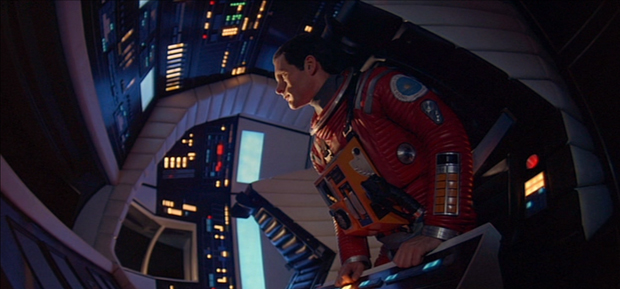
368 View on the CM4 screen of Poole exiting the pod. (1:31:14)
Very similiar to shot 309 below when Dave left the pod.
I have remarked previously on just what camera, supposedly associated with the ship, is doing the filming for some of these scenes, going into this at some length on the BBC interview section. Shots 294/295, of Dave viewed entering the pod, and then seeing supposedly live feed of it from behind Poole's shoulder, I considered could have been possibly filmed by HAL from the computer console in a neighboring room. Many of the shots of Dave's EVA, viewed by Poole, seemed unlikely to have been filmed by a remote camera.
Here, however....here there is no way possible, none whatsoever, that we have a camera associated with the ship filming Poole as he exits the pod. But we don't think about it because we have already viewed Dave exiting from the pod in like manner in shot 309. The shot of Dave exiting was camera-for-the-audience perspective. The director's perspective, not that of the ship's. I actually began examining this in sections one and two in which we had dominant shadow aspects to the side which eventually I associated with the photographer at the TMA-1 site. I noted how leading into and with the first monolith scene we'd had that overbearing shadow to the side which was much like Jack's shadow presence materializing out of nowhere as stepped from behind the support pillar studded with photographs in The Shining. We'd had the same overbearing shadow on the moonbus, later realizing that the photographer was on the moonbus though Kubrick films the scene as if the photographer was not, and then finally we have Kubrick filming the photographer who is shown as first reacting to the monolith's signal, beside whom we have the half red sphere (I cover that in section three), and over whose shoulder Kubrick films as he takes shots of the other astronauts before the symbolic convergence in shot 222. The camera, the photographer, is as much a presence in this film as any of the actors, but hidden.
In shot 294, when we are supposedly watching a live-feed on CM4 of Dave climbing in the pod, Kubrick is shooting from behind Poole's shoulder. In shot 318, when we are supposedly watching a live-feed on CM4 of Dave working to open the back of the communications dish (or crater), again we view this supposed live feed (which steps back briefly in time, as with shot 294) from behind Poole's shoulder.
Now as we watch this supposed live feed, on CM4, of Poole exiting the pod, again we are watching the scene from beyond Dave's shoulder, and what's shown on the monitor is a view of Poole which couldn't be from Discovery One.
This will happen again in a moment and I'll discuss it further then.
I'll note that typically, but not always, with over-the-shoulder shots of this type, Kubrick is strengthening a sense of doubling. Such as in The Shining when Jack is being served at the bar by Lloyd and we have shots over Lloyd's shoulder, the arm of his burgundy jacket makes a strong connection with the burgundy of Jack's jacket, and people do catch this and consider Lloyd perhaps as not a supernatural element but a double aspect of Jack.
THE LITTLE THINGS
369 Long shot of Poole floating toward the Discovery One, beyond the pod. (1:31:31)
The pod revolves away from us.
We very faintly observe here the same kind of lens flares that were in the shot when the Aries landed.
I'll make the lens flares a little more apparent below.
With Dave, when he had gone EVA, we were first shown, in shot 308, the pod revolving toward us, Dave not out of it yet. Then we had shot 309 of Dave exiting the pod, which was a horizontal flip shot as his air hose was on screen left rather than right.
We were then shown, in shot 310 below, Dave floating toward Discovery One.
Kubrick, with Poole, doesn't show the pod revolving toward us and Poole exiting. Instead, we are first shown Poole exiting the pod. Then we are in the next shot shown the pod revolving away from us, Poole already having exited. I believe the same footage of the pod's revolving in 308 is the same as in 369 as we have the same lens flares--and, very briefly, in shot 308 and 369, we see a bar of light reflected in the pod's window.
Below is that bar of light shown during Poole's walk and also in Dave's walk but before he exits the pod.
It isn't as if Kubrick couldn't afford special effects people to get rid of that glaring, shouldn't-be-there light in the pod's window. It isn't as if Kubrick isn't already using special effects here. So, why show this bar of light? It reminds somewhat of Kubrick having the door to room 236 open in the background when Danny has his first encounter with the door of room 237 which is at that point locked. One could feel a little rankled with the sense of the set-behind-the-magic-curtain view, or could wonder if this was intentionally there then what did it mean. But that bar of light a little more reminds me of the white bar in A Clockwork Orange that Alex is warned not to cross, that he is to keep his toes behind, when he is handing over his personal items as he enters prison, a white bar that is repeated in the scene when he is speaking to the warden of the prison as he signs himself over to the Ludovico treatment (he knows enough then to not cross it and makes a show of it), which I connect with white bars of light that discreetly appear when Alex, in bed, is receiving the photographers, the white bar hidden among the camera flashes but having nothing to do with the camera flashes. That white bar amongst the camera flashes is so discreet that the audience is pretty well oblivious to it. The white bar of light is part of that movie's internal story and Kubrick didn't need for the audience to be consciously aware of it.
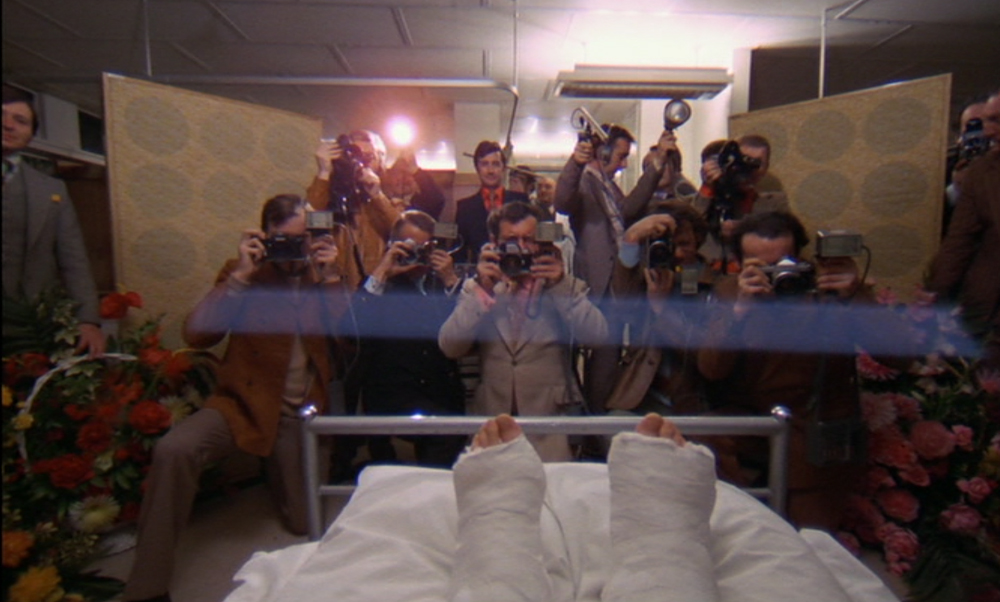
In A Clockwork Orange I feel the bar of light, which Alex's toes remain behind, represents an internalized line beyond which he shall not cross, not like that of the Ludovico treatment however, which caused him to become ill. Instead it is as the white line in prison behind which he was ordered to keep his toes--only that was external and this is internal.
The bar of light is seen in the scene with Dave and in the scene with Poole. A difference between the two scenes is we're shown the white bar of light when the pod is rotating away from the Discovery One in Dave's scene. We are shown the white bar of light when the pod is rotating toward Poole and the Discovery One in Poole's scene.
One could compare the light in the pod's window, that bright slash, with the white lights reflected in the pod bay.
But I'm concentrating too much on these things here, right now, and should continue on. I just wanted to note I feel these artifacts are intentional. Indeed, that bar of light in the window of the pod is going to appear again in a moment in shot 380, which is one reason I pay so much attention to it.
Shot 369 ends at this point below.
370 Medium shot side view of the pod. (1:31:54)
Shot 370 begins as below.
The pod rotates to face us. Its arms extend. It begins to come toward us.
Seems HAL doesn't have to depend on hominids for carrying out his actions, as the BBC had said. HAL has acquired hands through the pod.
We have some very obvious lens flares.
371 CU of pod and HAL's eye. (1:32:13)
372 Closer shot of pod and HAL's eye. (1:32:13)
373 Closer shot of pod and HAL's eye. (1:32:15)
Poole's breathing is silenced. Presumably, now is also when Poole's radio goes dead.
374 Closer shot of pod and HAL's eye. (1:32:15)
Kubrick will repeat these 3 lights in Danny's vision of the murder scene of the two girls in The Shining. In that film they are in shots 233, 235, 238 and 240. Each shot between them is of the girls standing in the hall zooming in closer to them, just as we have here several shots dramatically zooming in on HAL's eye.
First, we have Danny on his Big Wheel, his hands positioned on the handlebars, which reminds greatly of the robotic arms of the pod. The red bell could remind one of HAL's red eye.

Then the murder scene with the 3 bright lights in the window.
The camera returns to Danny with his hands over his eyes, then separating his fingers so we see one blue eye peering upon the scene, the vision of the murder scene now absent.
Just as the girls are pseudo twins, so do we have here the twinned astronauts with one of them murdered.
375 Closer shot of pod and HAL's eye. (1:32:15)
Kubrick rapidly zooms in on HAL's eye in 5 stages and we briefly see this final eye of HAL's is not the same as those of the pod. It is instead that mysterious eye of HAL, the one I've said shows reflections that can't be accounted for, and part of the light is even further obscured.
Below is the eye of HAL with the occlusion, the one we have seen ever since HAL questioned Dave on how he felt about the mystery surrounding the mission, and then forecast the failure of AE 35.
Shot 375 is the only time we will see that portion of the eye fully occluded, in conjunction with the attack on Poole. The full occlusion is for a reason and has everything to do with this scene.
If we scale down shot 375 to fit HAL's eye as we normally see it, judging by the reflections, we can a little better how the occlusion works.
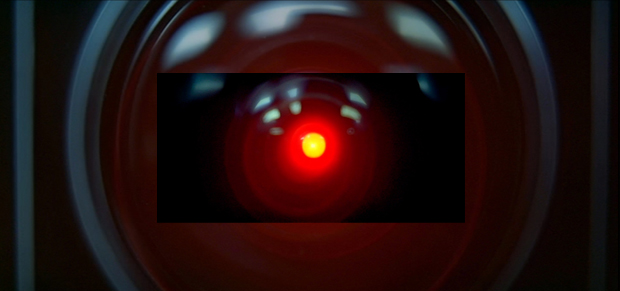
We can project it might look something like this if we had a full view of HAL's eye.
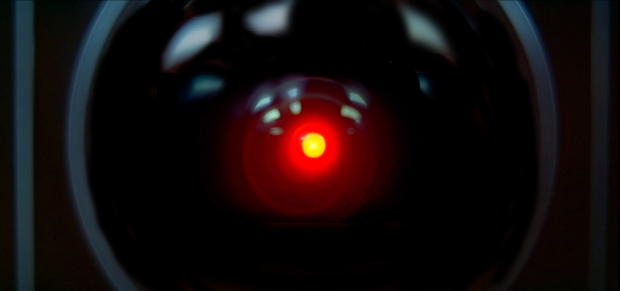
This is a very important shot, though one that flies by so quickly that we almost don't have a chance to realize that this eye we are seeing is not the eye of the pod, and certainly we don't have a chance to really take in the fuller occlusion.
376 Dave as in 367, on the flight deck. (1:32:15)
He jerks his head to the right to look at the CM4 screen.
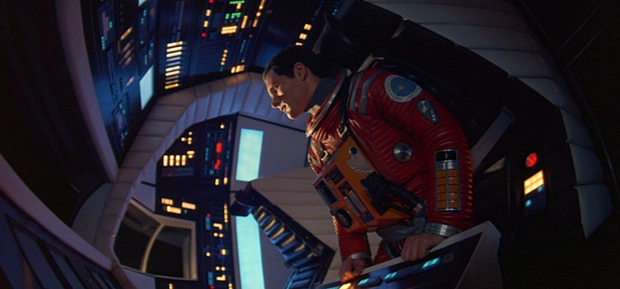
377 The CM4 screen and a shot of Poole flying past the communications dishes spinning counter-clockwise, his head toward the camera. (1:32:17)
Looks like an arrow, doesn't it, on the communications dishes, pointing to the left. A kind of bow and arrow as a matter of fact, the shadow arrow caused by the axis of spindle sticking out of the center of the dish.
Now to continue on the discussion from shot 368 of the absolute impossibility of certain camera views. Here we have this critical shot, once again from behind the shoulder, of CM4 appearing to give us what we are to take as a real time view of Poole flying into space, having been attacked by HAL operating the pod. This is what Dave is viewing on the ship. Are we to believe this shot was taken from a camera located at the rear of the ship's head, pointed back toward the dishes? Perhaps. Instead it seems to me every bit as impossible as the CM4 shot in 368 of Poole exiting the pod. Or let me put it this way--Kubrick, especially with shot 368 of Poole leaving the pod, and the manner in which it duplicates the shot of Dave leaving the pod, has seriously given us a lot to think about as to what these shots actually mean as far as the internal story goes. These are shots that don't get in the way of the primary storyline, they even appear to support it until one really takes a good look at them and realizes they are pertinent instead to the substrata.
378 Medium shot of Poole flailing in space, his air hose floating loose. He spins counter-clockwise, head toward the camera. (1:32:20)
Absolute silence.
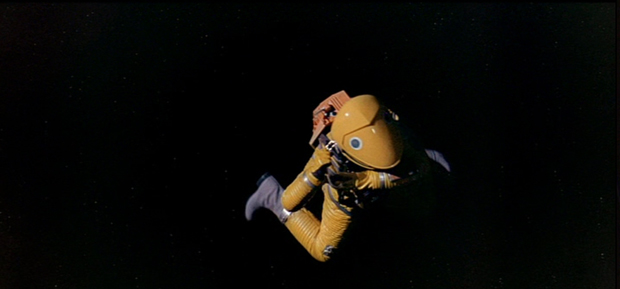
379 Dave rises from his seat and leaves the flight deck. (1:32:29)
It is from the same perspective as shot 305.
380 The pod hurtles away, abandoned by HAL. (1:32:32)
Utter silence as it flies past Poole who is spinning counter-clockwise but with his feet toward the camera, which means he is now spinning clockwise.
For two reasons, this is one of the crazier shots in the film.
With every flip, the little laundromat dryer pod shows that slash of white light in its window that I brought up in shot 369. All special effects and nothing but special effects going on here and we have that white light which is an impossible reflection that could have been done away with if it was an accidental reflection but it wasn't which means it is purposeful.
Though the pod has supposedly just murdered Poole, we apparently don't have the law of physics in force of equal and opposite reactions. Also, peculiarly, the pod and Poole actually cross paths here. They are coming from different sources and cross paths as they spin off at I guess something like a right angle to each other. And why is the pod hurtling like this in the first place? What happened back there that would make it careen off like this?
And that their paths intersect each other at perhaps a right angle?? That their paths intersect at all?
If we return to shots 369 and 370, if we take seriously where shot 369 leaves off and where shot 370 begins and then has the pod rotate 90 degrees toward us, the pod isn't moving toward Poole at all. In the below still, the arrow shows more the direction in which it would be going, and perhaps even a little further right. In shots 380 and 281, Kubrick is very precise in his cutting with the rotation of the pod as Dave prepares to go out in it, so that where the rotation leaves off in 380 is where it picks up in 381. With shots 369 and 370 we are given the impression of the same occurring based on our assumption of HAL murdering Poole.
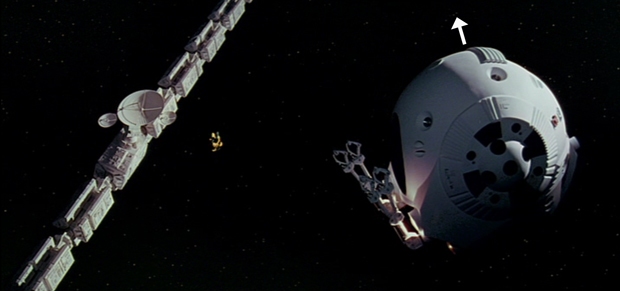
As I stated above a difference between the Poole and Dave scenes is in the Dave scene the pod is rotating away from the Discovery One when it shows the light and in the Poole scene the pod is rotating toward him. In both of these scenes we see a horizontal flip of Poole and Dave as they float toward the Discovery One. The horizontal flip/mirror imaging of Dave occurs after we've seen the rotation/light. The horizontal flip/mirror imaging of Poole occurs before and then at the same time we see the rotation/light.
Another difference between Poole's walk and Dave's walk is that we don't have Poole shielding himself with the sun screen.
THE SHOW DOWN
DAVE PURSUES POOLE IN ABSOLUTELY THE OPPOSITE DIRECTION FROM WHICH HE'D DISAPPEARED
381 Dave climbs down into the room off the pod bay. (1:32:46)
The whole perspective of this scene is the same as shot 347 when Dave and Poole went down to the pod bay with their cover story to examine pod C.
BOWMAN: (Prepare G pod) for EVA, HAL. Have you...
I can't tell what Bowman says at the beginning here and had to rely on someone else.
Shot 380 | Shot 381 |
 |  |
382 View of Dave from opposing side of room. (1:33:01) This is from about the same perspective as shot 292 when Dave entered the room to go EVA previously.
HAL: The radio is still dead. 383 Extreme long shot of Poole and the Discovery One beyond him. (1:33:17)
Silence as Poole, head first, sails toward the camera and over it, spinning counter-clockwise. This replicates the shot of the asteroids, 296, as seen below. Well, it replicates 296 with the exception that Poole is spinning off to the "left" of Discovery One (thinking of the pod as having been originally on its right and Poole having approached from its right). This seems to fit with shot 377 in which the viewer is given the impression of Poole spinning off to the left. The Discovery One, in this shot, has its head to the left and the thrusters to the right, which fits this scenario. Thus the orientation of the Discovery One is horizontally flipped from what it is in the asteroid shot in which the head of Discovery One is facing right. 384 CU of the back of the pod closing and showing the CAUTION EXPLOSIVE BOLTS sign. (1:33:23) This replicates shot 352, below, when Poole and Dave went into the pod to discuss HAL. 385 Medium shot from the side of Dave within the pod. (1:33:27) 386 Medium-long shot from the rear of Poole floating in space. He spins counter-clockwise which means he is now spinning clockwise. (1:33:30) 387 Exterior shot of the pod bay door opening. (1:33:35) 388 Medium CU of Dave from the front in the pod. (1:33:41) 389 Medium long shot of the pod sliding out of Discovery One on its platform. (1:33:46) 390 Poole floating further and further away. (1:33:53) 391 Medium CU of Dave from the front in the pod. (1:34:04) 392 Shot from behind the Discovery One as the pod rises in front of it. (1:34:11) 393 Shot from the side of the head of the ship of the pod as it rises and revolves. (1:34:18) 394 Medium CU of Dave from the front in the pod. (1:34:24) 395 Medium shot of Poole floating, spiraling in space. (1:34:28) 396 Medium CU of Dave from the front in the pod. (1:34:38) 397 The pod rises into view from lower right screen. (1:34:47)
BOWMAN: ...made radio contact with him yet?
BOWMAN: Do you have a positive track on him?
HAL: Yes, I have a good track.
BOWMAN: Do you know what happened?
HAL: I'm sorry, Dave. I don't have enough information.
BOWMAN: Open the pod door, HAL.
Dave climbs in.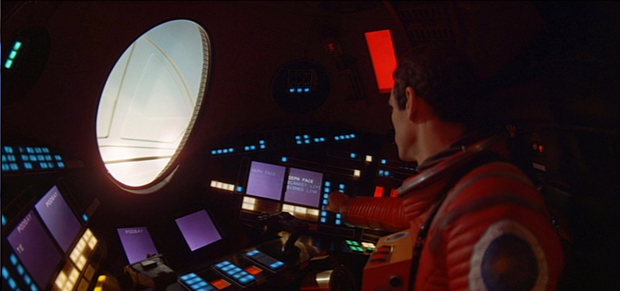
Silence.
Silence.
Silence.
Spins counter-clockwise with his feet toward us, which means he is now spinning clockwise. Silence.
Silence.
Silence.
He floats counter-clockwise, feet toward us, which means a clockwise spin. Silence.
Silence.
Shot 386 | |
 | |
Shot 387 | Shot 388 |
 |  |
Shot 389 | Shot 390 |
 |  |
Shot 391 | Shot 392 |
 |  |
Shot 393 | Shot 394 |
 |  |
Shot 395 | Shot 396 |
 |  |
Shot 397 | |
 | |
398 Shot from the side of Dave in the pod, bathed in red light. (1:34:57)
399 Discovery One as in shot 277 (exactly) with the pod coming toward the camera. (1:35:10)
Silence.
In earlier shots, we are led to believe that Poole spun off to the "left" of Discovery One, on the opposite side. Dave is coming straight toward us at a 90 degree angle from Discovery One, on its "right side". This is the reverse of what his orientation should be.
In this shot the communication dish appears to be pointed to the rear of Discovery One rather than toward the head. If we go back to shot 277 and decide instead that dishes are pointed to the rear there (the dishes, however, are constantly revolving) then we could say then that in shot 277 we instead have Poole spinning off to the right. Though that is impossible as he is on the right of Discovery One in the first place when he exits the pod. And, again, in shot 383, Poole is shown flying off to the left. There's no way getting around that view.
But there's also no way getting around the fact that Kubrick now has Bowman chasing Poole to the right of Discovery One.
400 Medium CU of Dave from the front in the pod. (1:35:17)
401 CU of Poole as dot target on screen. (1:35:20
The screen shows Dave's pod "closing 45+".
402 Dave from above navigating the craft. (1:35:25)
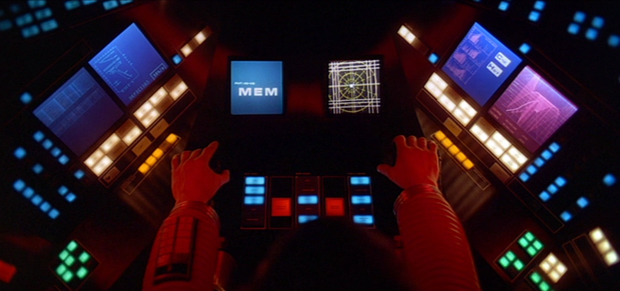
403 Black out the window of the craft. (1:35:53)
404 Poole spiraling counter-clockwise in space. (1:35:40)
His head is toward us. Silence.
405 The pod in the distance coming toward the camera. (1:35:47)
Silence.
406 Medium CU of Dave from the front in the pod. (1:35:56)
407 Black out the window of the craft, as in shot 403. (1:35:59)
408 CU of Poole as dot target on screen. (1:36:06)
409 Black out the window of the craft, as in shot 407, but Poole now appearing as a small dot in the distance. (1:36:16)
410 Medium CU of Dave from the front in the pod. (1:36:22)
411 Black out the window of the craft, as in shot 409, but Poole as small dot now growing a little larger. (1:36:30)
Poole grows large enough in the window to be discernible as human.
412 Medium CU of Dave from the front in the pod. (1:36:54)
We hear the sound of the target being locked on.
413 Medium long shot of pod. (1:37:04)
Silence. Poole floats into the frame from the left, feet toward us, spinning counter-clockwise (which means a clock-wise spin with head toward us).
414 Shot as 398, Dave from the side in the pod. (1:37:25)
415 Medium long shot of Poole spinning. (1:37:38)
Silence. Poole's head is toward us. He spins counter-clockwise. The pod enters from the left and, arms extended, catches him.
Shot 404 | Shot 405 |
 |  |
Shot 406 | Shot 407 |
 |  |
Shot 408 | Shot 409 |
 |  |
Shot 410 | Shot 411 |
 |  |
Shot 412 | Shot 413 |
 |  |
Shot 414 | Shot 415 |
 |  |
416 CU of Dave from the front. (1:38:17)
This is a slightly closer in shot than the others so far. He breathes an obvious sigh of relief, though aggrieved. He looks up at the camera.
THE DREAMLESS SLEEP OF THE HIBERNATORS
417 CU of HAL's red eye in response. (1:38:31)
418 Empty pilot's chairs on Discovery One from HAL's POV. (1:38:36)
What happens if we take the image of HAL's eye and combine it with the one of the pilot's chairs, only reversing the pilot's chairs, as they would appear as a reflection on HAL's eye?
What we get is image 346 only with the pilots absent.
I compare these shots because 418 certainly recalls shot 346, our last view had of this area when Dave asked Frank to go down with him to check on a communication problem in one of the pods. They also recall HAL's interview of Dave.

419 Two of the hibernator pods. (1:38:44)
This is a repeat of 245.
420 MCU of hibernator pod. (1:38:54)
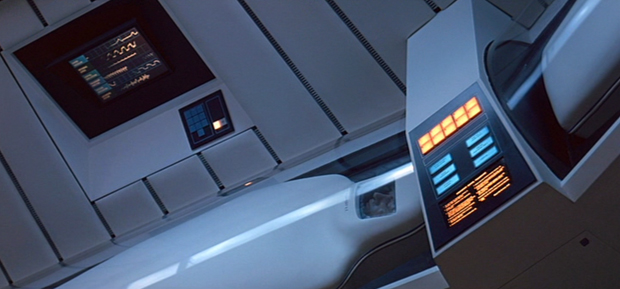
421 CU of life support system screen of a pod. (1:39:05)
This is a near repeat of shot 246.
COMPUTER MALFUNCTION flashes red and the unit starts beeping. We then return to the support system read out with the metabolic levels and system integration red.
The hibernators of 2001, unlike Wendy who is roused by Danny's "Redrum" chant in The Shining, can't awaken from their dreamless sleep and are lost.
422 J. R. Kimball's pod. (1:39:29)
423 V. F. Kaminsky's pod. (1:39:30)
424 J. R. Kimball's pod again. (1:39:33)
Shot 424 is pretty much an exact shot of 243 of Kaminsky. And a little interesting that Kaminsky is in shot 423 just previous this one.
425 All three pods but seen inverted from 419. (1:39:36)
It is not a flipped image. Simply inverted.
426 CU HAL's red eye. (1:39:40)
427 COMPUTER MALFUNCTION screen (1:39:44)
Then LIFE FUNCTIONS CRITICAL against orange. The life support readings come back on and CARDIO VASCULAR, METABOLIC LEVELS, PULMONARY FUNCTION and SYSTEMS INTEGRATION are red. Metabolic levels and system integration have flattened. LOCOMOTER SYSTEM goes red and flattens. Metabolic levels flatten. Cardio vascular flattens and then finally the central nervous system. LIFE FUNCTIONS TERMINATED.
Shot 422 | Shot 423 |
 |  |
Shot 424 | Shot 425 |
 |  |
Shot 426 | Shot 427 |
 |  |
428 View of the 3 pods. (1:40:20)
This is a repeat of 241 and is a horizontal flip from what the orientation should be.
It is also, in a way, a repeat view of shots 228-230 of this area horizontally flipped like this when Poole is running through it, exercising.
It seems notable that Kubrick ends our experience with the hibernators on this flip horizontal view of them, just as we have Poole flying off to the "left" of the ship but Dave has retrieved the body from the "right" of the ship.
AGAIN, THE EYE OF HAL WHICH IS NOT THERE
429 CU HAL's red eye. (1:40:25)
430 MS of the computer console on the pod deck and the red helmet hanging beyond. (1:40:34)
BOWMAN: Open the pod bay doors, please, HAL.
431 Dave's pod waiting outside the Discovery One. (1:40:42)
BOWMAN: Open the pod bay doors, please, HAL.
432 MCU of Dave from the front in the pod. (1:40:51)
BOWMAN: Hello, HAL. Do you read me? Hello, HAL. Do you read me? Do you read me, HAL?
Shot 429 | Shot 430 |
 |  |
Shot 431 | Shot 432 |
 |  |
433 Exterior of the pod bearing the body of Poole. (1:41:06)
Silence. Which is broken by Dave's voice.
BOWMAN: Do you read me, HAL?
Such a classic, gut-wrenching shot.
434 The Pod observed through the window of the flight deck. (1:41:11)
BOWMAN: Hello, HAL, do you read me?
435 Exterior of Discovery One, viewed 3/4 from the rear, with the pod in front.
BOWMAN: Hello, HAL, do you read me? Do you read me, HAL?
HAL: Affirmative, Dave, I read you.
436 MCU Dave in the pod. (1:41:23)
BOWMAN: Open the pod bay doors, HAL.
437 Repeat shot 430 of the computer console in the pod bay. (1:41:28)
HAL: I'm sorry, Dave. I'm afraid I can't do that.
438 MCU Dave in the pod. (1:41:33)
BOWMAN: What's the problem?
HAL: I think you know what the problem is, just as well as I do.
BOWMAN: What are you talking about, HAL?
439 CU HAL's red eye. (1:41:43)
HAL: This mission is too important for me to allow you to jeapordize it.
440 MCU Dave in the pod. (1:41:47)
BOWMAN: I don't know what you're talking about, HAL.
441 CU HAL's red eye. (1:41:52)
HAL: I know that you and Frank were planning to disconnect me, and I'm afraid that's something I can not allow to happen.
442 MCU Dave in the pod. (1:42:01)
BOWMAN: Where the hell'd you get that idea, HAL?
443 CU HAL's red eye. (1:42:08)
HAL: Dave, although you took very thorough precautions in the pod against my hearing you, I could see your lips move.
444 MCU Dave in the pod. (1:42:18)
BOWMAN: All right, HAL, I'll go in through the emergency air lock.
445 Repeat shot 436 of the computer console in the pod bay. (1:42:37)
HAL: Without your space helmet, Dave, you're going to find that rather difficult.
446 MCU Dave in the pod. (1:42:45)
BOWMAN: HAL, I won't argue with you any more. Open the doors.
447 CU HAL's red eye. (1:42:50)
HAL: Dave, this conversation can serve no purpose any more. Goodbye.
448 MCU Dave in the pod. (1:42:56)
BOWMAN: HAL? HAL. HAL. HAL! HAL!!
Shot 435 | Shot 436 |
 |  |
Shot 437 | Shot 438 |
 |  |
Shot 439 | Shot 440 |
 |  |
Shot 441 | Shot 442 |
 |  |
Shot 443 | Shot 444 |
 |  |
Shot 445 | Shot 446 |
 |  |
Shot 447 | Shot 448 |
 |  |
I have brought up how we never see anywhere in the ship these reflections on HAL's eye, as in shot 447. We only observe them in the CU shots. One could say, "But We see them in CU," but that isn't enough, because these reflections are too important, as evidenced by Kubrick's use of them in shot 375, when we go from the pod's eye of HAL to this one only this time we have even more of an occlusion.
As close as we get to a room in which this reflection could occur, though is never seen in HAL's eye there, is the pod bay.
If we superimpose HAL's eye over the pod bay we get this.
So is the source of the reflection in the pod bay? But what of the obfuscation of the center light, which I have repeatedly brought up?
While I'm briefly idling here, note how the three primary lights in the ceiling are echoed at a 90 degree angle in the adjoining hall. This hall, we know from shot 291, is an octagonal hall with "circles" of 8 lights that repeat in a vanishing point-infinity perspective. Actually, more than 8 lights as the light on the "floor" is segmented into 3 parts.
The audience may see shots 437 and 445, in which we are shown the red helmet in the pod bay, as from the POV of the cinematographer, because they haven't the perspective we associate with the few shots we have of HAL's view. However, it seems to me important that the reflections off HAL's eye, in CU, don't match with any that we are seeing in the film except for the ones I've just noted, the perspective as shown in shot 445, and yet there is no eye of HAL there to give us this perspective. It can't be said, "Well, maybe it's the eye of HAL view point from the pod that was there," because not only is the central pod not there for many of these views, but the eye of HAL on the front of the pod is different, housed in a white casing. What I'm going to remark on is that Kubrick has many times shown us this view of the red helmet from that perspective of shot 445, the same one that matches perhaps with the reflections in HAL's eye (which is not there), and so we have no problem with HAL remarking that Dave will have problems getting in without his helmet. But is this a knowledge that HAL is in a position to possess? HAL's console eye in the pod bay area faces the opposite direction. Is he processing information from other cameras rather than his console?
"But it's fiction! Kubrick has the law of suspension of disbelief on his side, which is given extra latitude in science fiction! Plus, HAL is supposed to have evolved."
I would agree on that point with most directors, and though Kubrick may be taking advantage of suspension of disbelief, he is not handling it as would most directors.
HAL's eye is still showing the obfuscation that was not there, except for one shot, before his conversation with Dave in which he questioned him on the mystery of the journey and then warned about the failure of AE35. That obfuscation, a portion of light reflection that was fully eclipsed during the death of Poole, is significant and a mystery.
If we go back to that single shot of HAL, before his critical conversation with Dave, when we saw the obfuscation, is there anything in that shot that may help with this mystery? Why was there an obfuscation in that shot, which then went away, only to appear again later in shot 272, and which will continue obfuscating HAL's eye until the penitent HAL endeavors to talk Dave out of disconnecting his higher functions?
The answer to my questions isn't to be had, but we do notice one thing. In the other shots of HAL's eye that show the reflections, obfuscated or not, we only see those reflections of the light. When HAL is dialoguing with Dave we only see those reflections. With the death of Poole, we only see those reflecttions. Always, we only see those reflections. However, in this very first shot of HAL's eye, in shot 230, when we are introduced to HAL, before we know what it is we are viewing, we see in HAL's eye not only the light reflections with the obfuscation, we also see the reflection of Dave in the chamber. Dave appears to be rotating but instead it is HAL's eye that is rotating. Those light reflections match nothing we are seeing in that chamber. They are a superimposition from another place. The pod bay area? But, as we have discussed, there is no matching eye of HAL's, in the pod bay area to give this perspective even though the lights could match. And if there was, we don't have the obfuscation explained.
The most important thing is we are seeing two reflections, one of Dave, and one from someplace else.
When people say that HAL has cracked because he is a computer and computers, by nature of their programming, must tell the truth (which is the reasoning of many), what they are really saying is that his responses and actions at this point have all to do with programming and a programming conflict and that HAL is still, yes, a computer, with all actions controlled purely by algorithms rather than intentionality, and that any intentionality as seen in the movie is actually a result of erroneous programming. Kubrick, in the interview with the BBC, has in no way proposed to the audience that HAL is a computer that can act on conceptual knowledge. The interview with the BBC addresses emotion--does HAL have feelings, such as pride. Those in the audience who would say, "yes", would also still admit that they are thinking of HAL as a computer that has freakishly managed to develop feelings as it has been programmed to mimic human emotion. The audience understands it is anthropomorphizing HAL--and Kubrick certainly takes advantage of our tendencies to anthropomorphize--but to credit HAL with having taken such a huge evolutionary leap that the computer is now purely functioning as a thinking individual?
"It's science fiction."
The lights of shot 447 perhaps being observed in shot 445, and HAL having knowledge to which the computer is not privy visually, knowledge which is repeatedly shown in 445 in tandem with HAL's eye, as if he is experiencing it from this viewpoint, though the perspective is that of the director/audience, creates a real problem for the audience. And it is a real problem that Kubrick is presenting in the sub-strata.
The audience, yes, has accepted that HAL has been able to "learn", to teach itself, by his developing the skill of lip-reading. I think the audience understands this was likely not in its programming. Yes, they are thinking of HAL at that point as not just a computer that is programmed to logically anticipate the future (chess moves) but as very near an intelligence. But all kinds of mushy thinking is going on as the audience still also thinks of HAL as driven by its programming to protect its mission.
Actually, there are problems in that scene with HAL being able to read lips when he had to ask Dave to hold the portraits up to him so he may "see" them more readily. And there's already a problem with HAL being able to "judge" art, which takes him leaps and bounds beyond logically anticipating the future. But we have something more than that here. We have HAL knowing information that may not be available to him. Kubrick is very careful to show us what HAL actually sees and how actually sees, and the eyeviews of HAL Kubrick presents us with in, say, shots 418 and 251 and 269 are not a 100 percent coverage of the Discovery One due some kind of omniscient vision.
Even if we do accept that HAL has made such a profound evolutionary leap as to absolutely break free of its algoritthms, the question begs to be asked as to the "how".
Even if we do accept that HAL is a free-thinking entity now, the question begs to be asked how HAL has information beyond his perceptual grasp? Kubrick will drive this point home before this section is done. He will again be asking us how it is that HAL has information beyond his perceptual grasp.
449 Repeat of 431, the small pod facing off with Discovery One. (1:43:17)
Silence.
450 The pod bearing Poole's body. Repeat shot 433. (1:43:24)
Silence.
451 The pod bearing Poole's body before the ship which is viewed 3/4 from behind. Repeat shot 435. (1:43:29)
Silence.
452 Front view of Dave in the pod. (1:43:35)
453 The Pod observed through the window of the flight deck. Near repeat of shot 434. (1:43:59)
454 Pod viewed from below. (1:44:03)
Silence. The pod moves away from the ship.
455 CU Dave inside the pod. (1:44:16)
Shot 451 | Shot 452 |
 |  |
Shot 453 | Shot 454 |
 |  |
Shot 455 | |
 | |
456 The pod releases the body of Poole. (1:44:34)
Poole runs the danger of becoming almost less than a character and more a plot point, but for the fact these are powerfully strong scenes of Dave pursuing him and then presenting Poole's dead body before the Discovery One. They have the power of Greek tragedy. Kubrick doesn't show us Poole's death intimately. We are looking at HAL when we hear Poole's breathing cease, then next we have Poole's hyper-frenetic motions as he attempts to reattach his air hose and those motions also distance us. We never see his face after shot 365 when we are given a last view of him, in CU, and he looks directly at us, breaking the fourth wall. We see him in shots 366, 368 and 369, but not his face, not even dimly, not even his profile. Then he is dying, then dead, and still we will not see his face. We hear his breathing up to the point when his air hose is detached, but in connection with this we hear no scream, no protest, and there is no radio contact afterward.
Dave is a character that shows almost no emotion, but his struggle to claim the body of Poole has been a desperately urgent one. He's aware he is pursuing a dead body, and it is vitally important that he claim that body in respect of human psychology.
The pods are easily anthropomorphized and throughout these scenes they appear as masks conveying mute screams of horror that surpass individual tragedy with an ancient gaze. Because we don't see Poole's face, and because Dave is so self-contained, it's the machines that do the job of expressing emotion. Cute is a danger with anthropomorphism yet none of Kubrick's machines begin to stray into this territory.
Now, heartbreak upon heartbreak, Dave must release Poole to the void.
Heywood's daughter had asked for a bushbaby for her birthday. A lemur. The ghostly lemuria were sometimes conceived of as restless spirits who had not received a proper burial. The legend was the Feast of Lemuria was established by Romulus to appease the spirit of his twin Remus, the founders of Rome. How had Remus died? Romulus and Remus had argued about where Rome should be located. Romulus wanted Palantine Hill. Remus wanted Aventine Hill. Through augury, Romulus claimed divine approval. Yet still they argued and Remus was killed by either one of Romulus' supporters or Romulus himself. Most accepted seems to be the story that Romulus killed his twin brother.
457 Out the dark window of the pod, Poole's body spirals away, feet toward the window, counter-clockwise. He becomes smaller and smaller. (1:44:41)
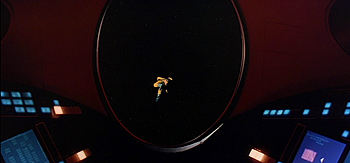
458 CU Dave. (1:44:52)
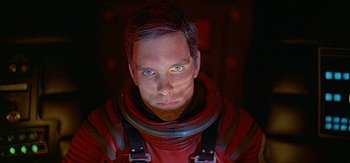
459 The pod turning back toward the ship, Poole's body beyond. (1:45:07)
Silence. Some brilliant refractions.
460 CU Dave. 1:45:20
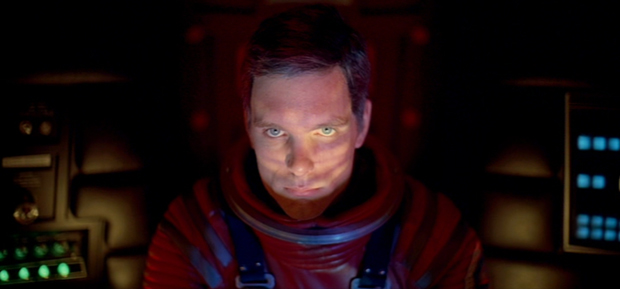
461 Out the pod's window, view of the ship with its emergency air lock. (1:45:31)
Zoom in as the pod nears it.
462 Side view of the pod facing the air lock.(1:46:02)
Silence.
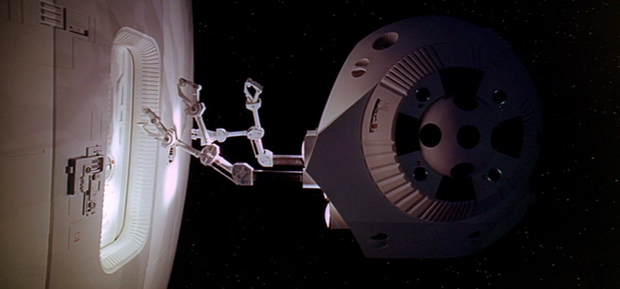
463 CU of the pod's "hands" reaching toward MANUAL OPERATION ONLY locks. The one on the left is horizontal. The one on the right is vertical. It turns the one on the left, the horizontal one, clockwise. (1:46:14)
The horizontal and vertical here should be compared to others of this type in the film, such as the horizontal/vertical in shot 320.
464 CU Dave. (1:46:23)

465 View from above the pod as the left "arm" withdraws. The right one turns its lock counter-clockwise. The air lock opens. (1:46:29)
466 CU Dave. (1:46:54)
467 Side view of the pod. (1:46:58)
Silence. It pulls away, revolving toward us. None of the colorful refractions as seen earlier, just bright white glare for a moment. Completes its 180 degree turn with its back against the door of the lock.
468 View from inside the air lock of the door of the pod. (1:47:41)
Silence.
469 MCU Dave in the pod. (1:47:44)
470 CU of Dave's hand pulling open some kind of switch. (1:48:10)
471 MCU Dave. (1:48:10)
472 CU of Dave's hand pressing three buttons that were under the switch plate. (1:48:16)
Above, a red light comes on between two red arrows pointed toward it on either side.
473 MCU Dave. (1:48:23)
Dave undoes his straps, turns and lies face down on his seat facing the rear door.
Considering the name Bowman, and that I think we're dealing with a kind of Sagittarian arrow as we find also in Eyes Wide Shut, thought I'd put here some info on the word bolt from the Online Etymological Dictionary.
Old English bolt "short, stout arrow with a heavy head;" also "crossbow for throwing bolts," from Proto-Germanic *bultas (cf. Old Norse bolti, Danish bolt, Dutch bout, German Bolzen), perhaps from PIE root *bheld- "to knock, strike" (cf. Lithuanian beldu "I knock," baldas "pole for striking").
Applied since Middle English to other short metal rods (especially those with knobbed ends). From the notion of an arrow's flight comes the lightning bolt (1530s). A bolt of canvas (c.1400) was so called for its shape. Adverbial phrase bolt upright is from late 14c.
I wrote back in section three, on Taurus...
Taurus and its relationship to the rest of the year as expressed by the site Ohr Somayach is pretty interesting.
The cycle of the mazolot (astrological signs), is like the cycle of the life of a man: In the beginning, when he is born, Man is like a lamb (T'leh/Aries) - soft and delicate. As he grows, he becomes powerful like an ox (Shor/Taurus). Then he becomes like the twins (Teumim/Gemini): He sees himself as complete and perfect. Then his yetzer hara (negative impulse) starts to grow. At first it is as small as a crab (Sartan/Cancer), but if left unchecked, it becomes as strong as a lion (Arieh/Leo). If he sins, his yetzer hara puts on the mask of innocence, appearing as pure as a maiden (Betula/Virgo). And if he continues to transgress, he is placed in the Scales (Moznaim/Libra), and his fate is weighed in the balance. If he persists in his rebellion, he is sent down to the depths, placed in a pit like a scorpion (Akrav/Scorpio). However, if he has a change of heart and returns to G-d, he is rocketed out of the pit like an arrow from the bow (Keshet/Sagitarius). Then he is transformed, returned to his former state of innocence and becomes like a kid (G'dee/Capricorn) - purified by the waters of the water-carrier (D'lee/Aquarius). His life comes full-circle when like a fish (Dagim/Pisces), he luxuriates and basks in the water of eternity, his soul reposing in the higher world from which it came.
Shot 466 | Shot 467 |
 |  |
Shot 468 | Shot 469 |
 |  |
Shot 470 | Shot 471 |
 |  |
Shot 472 | Shot 473 |
 |  |
474 CU Dave. (1:48:45)
He reaches up and presses an off screen button which starts a siren. Presses another. A third. He lowers his head and prepares for ejection.
At the last moment he closes his eyes.
This shot takes us back to shot 356.
The boundary on the open center space is comparable to the outlines of HAL's eye.
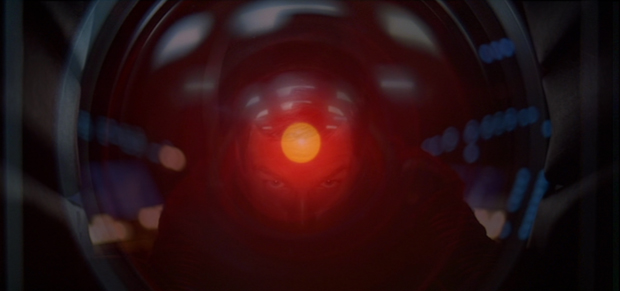
475 View of the pod door from within the air lock. (1:49:01)
476 Opposing view within the air lock. (1:49:06)
477 View of the open air lock door. (1:49:09)
Dave does a counter-clockwise turn this time flying back toward the open door. He grabs the wall.
I guess we are expected to ignore that the door of the back of the pod has disappeared. And I'm going to do just that, I'm going to ignore it.
478 CU Dave's hand pulling the EMERGENCY HATCH CLOSE. (1:49:11)
479 View toward the air lock door as it closes and sound of pressurized air entering begins. (1:49:17)
Shot 477 | Shot 478 |
 |  |
Shot 479 | |
 | |
480 CU HAL's red eye. (1:49:22)
The white reflected lights on the eye are now tinged with pink. This suggests this eye is in that chamber and yet it is not.
At about 1:49:30 begin crossfade to Dave.
481 CU Dave with helmet on, bathed with red light. (1:49:33)
As he fills the screen it is difficult to tell if he is still in the air lock.

When we see more, we realize that he is in the air lock.
482 Opposing view from behind Dave as he walks toward a door that resembles the rear air lock door. (1:49:36)
But the rear air lock door didn't appear to have a window in shot 476. The brief glimpse of the full door only showed black.
He exits into the pod bay area. This air lock appears to be parallel the chamber down which he came to the pod bay before going EVA for the Alpha Echo 35. This is how that entrance appeared in 291.
So one is given the feeling of passing through the same place as they are similar, but they are not the same, and one door opens onto the pod bay at an angle next the other.
A similar effect happens in The Shining. Wendy comes running down the bright red painted hall, which is such a shock in the film. She approaches what the audience believes to be the hall beyond Ullman's office, and it even has a picture hanging in it that we have seen in the hall beyond Ullman's office. The audience accepts it is that hall even though Wendy sees at the end of it the elevators. Actually, the hall is placed so that is instead in an area that falls a few feet short of where the hall beyond Ullman's office should be and has different doors.
As we see this scene in The Shining, one that has been anticipated from the beginning of the film, foretold by Danny's vision, Jack is in the maze chasing Danny, his personality disintegrating to animalistic grunts. Danny, in fact, has hidden himself in the heart of the maze using the reverse aspect plus 90 degrees turn equals a disappearance formula that I have discussed. Jack passes over him and, subsequent the vision of this red hall, Wendy and Danny are immediately reunited and escape. We have much the same here for HAL will now assume a very child-like aspect and his personality will disintegrate as Dave disengages much of his memory bank and logic center, though not all of it.
The color pink. Pink is a color that makes a strong showing here, even appearing in HAL's eye. If we look back to Heywood's arrival at Space Station 5, we had also a strong show of pink in the scene in which he exits the elevator in which he says to the attendant, who is dressed in pink, that he will see her on the way back. He then spoke with another attendant in pink and went through the voice print identification procedure in which he was asked to give his name and country of origin and destination. Very soon, here, HAL will in effect go through the same, as Dave disables much of his memory bank and logic center, relating his "birth day" and place and the name of his "father". After which Heywood will appear and make his revelation to Bowman on the monolith and its association with Jupiter.
HAL: Just what do you think you're doing...
483 MCU front view of Dave. He wears a green helmet. (1:49:47)
HAL: ...Dave.
484 3/4 view from side of Dave CU as he enters the chamber beyond the pod bay area which has the ladder. (1:49:52)
As he begins to climb the ladder, HAL continues.
HAL: Dave, I really think I'm entitled to an answer to that question.
485 Interior of a white door slides open. (1:50:19)
HAL: I know everything hasn't been quite right with me. But I can assure you, now, very confidently, that it's going to be all right again.
Dave has opened a panel in a wall and removed a key. He goes to a door in the white hall below another eye of HAL and inserts the key and turns it clockwise.
Shot 483 | Shot 484 |
 |  |
Shot 485 | |
 | |
486 CU of HAL's eye in the white chamber. (1:50:43)
HAL: I really do.
This CU view of HAL's eye is nothing at all like anything we've seen before. Finally, the 3 reflected lights are gone and we are seeing what at least appears to be a real reflection in HAL's eye, in CU, in this room, but it too is doctored and symbolic for notice that the yellow circle at the center is now half-colored red.
Dave's helmet, though green, is also given the appearance of being here yellow in this reflection. Poole's helmet was yellow and so this yellow appearance of Dave's helmet, in the reflection is not to be ignored. But the red crossing over into the yellow, according to what we shall next see, is a step toward red overtaking the entire eye, despite the fact Kubrick has the eye shaded with a good deal of background blue here, which is also a first.
Anyway, that is, I believe, a yellow helmet. It's certainly not dark green.
487 CU LOGIC MEMORY CENTER sign. MAXIMUM RESTRICTED ENTRY. (1:50:47)
HAL: Look, Dave...
488 MS from below Dave of him turning the key in the lock. (1:50:53)
HAL: I can see you're really upset about this.
Dave turns the key in a lower lock.
HAL: I honestly think you ought to sit down calmly, take a stress pill and think things over.
Dave pulls open the large door. He enters the red lit chamber beyond.
HAL: I know I've made some very poor decisions recently.
489 LS from above of Dave entering the brain room. (1:51:22)
HAL: But I can give you my complete assurance, that my work will be back to normal.
490 Opposing view of Dave entering the room. (1:51:28)
Shot 487 | Shot 488 |
 |  |
Shot 489 | Shot 490 |
 |  |
491 Dave reflecting in HAL's eye in the brain room. (1:51:33)
This reflected view must come from a eye of HAL's that is at the "top" of this chamber.
HAL: I've still got the greatest enthusiasm and confidence in the mission. And I want to help you.
492 Opposing view again of Dave. (1:51:46)
HAL: Dave, stop.
493 MCU of Dave from below. (1:51:52)
HAL: Stop. Will you?
494 View of Dave from above. (1:51:58)
He has taken out another key and begins turning HAL off.
HAL: Stop, Dave. Will you stop, Dave? Stop, Dave.
495 Side view of Dave from his right, HAL next to the camera on the right. (1:52:22)
Here we see HAL's eye to the screen right of his memory bank/logic center. In shot 491 we had a reflected view of Dave from HAL's eye that would be from the top of the chamber, showing the circular entrance way below Dave, whereas this eye of HAL's is located in the side. That view was not from this eye.
HAL: I'm afraid. I'm afraid, Dave.
Shot 492 | Shot 493 |
 |  |
Shot 494 | Shot 495 |
 |  |
496 CU of the IV-2 LOGIC TERMINAL, IV-3 LOGIC TERMINAL and MEMORY TERMINAL (1:52:37)
HAL: Dave, my mind is going. I can feel it. I can feel it. My mind is going. There is no question about it.
497 CU Dave from the side. (1:53:13)
HAL: I can feel it.
498 MS from behind of Dave and HAL to his right. (1:53:21)
HAL: I can feel it.
Shot 497 | Shot 498 |
 |  |
499 Dave from above. (1:53:27)
HAL: I can feel it.
500 Dave from below. (1:53:39)
HAL: I'm a...fraid. Good afternoon...
501 CU Dave from the side. (1:53:53)
HAL: ...gentlemen. I am a HAL nine thousand computer. I became operational at the HAL plant in...
Shot 500 | Shot 501 |
 |  |
502 CU logic and memory center. (1:54:13)
HAL: ...Urbana, Illinois on the 12th of January, 1982. My instructor was Mr. Langley, and he taught me to sing a song. If you'd like to hear it, I can sing it for you.
HAL is as Heywood in shot 129 supplying his name and country of origin for voice print identification. This is his identity. He is giving his name, his place of birth, and the name of his father.
With HAL's giving his place of birth, we are reminded again of Poole's birthday wishes scene with his parents , and the scene in which Heywood calls his daughter and informs her he won't be there for her birthday party.
503 CU side view of Dave. (1:54:36)
BOWMAN: Yes, I'd like to hear it, HAL. Sing it for me.
HAL: It's called...Daisy. Daisy, Daisy...
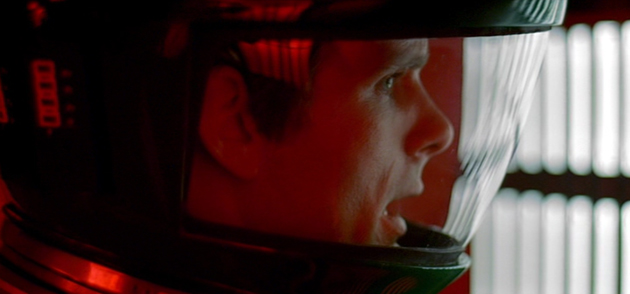
504 CU HAL's eye, Dave reflected in it. (1:54:54)
HAL: ...give me your answer, do. I'm...
The layerings of reflections in HAL's eye are interesting. The blurring on the periphery seems to connect with the beyond the inifnite trip which will soon follow. We have at least 3 composite reflections here. If you look back to shot 491 you will see that these peripheral blurs match up with the peripheral blurs there.
The white light at HAL's center, tinged with green, is now in the shape of a hexagon.
505 CU side view of Dave. (1:55:01)
HAL: ...half crazy, all for...
506 CU HAL's eye, Dave reflected in it. (1:55:07)
HAL: ...the love of you. It won't be a...
507 CU front of Dave. (1:55:14)
HAL: ...stylish marriage. I can't afford a carriage. But you'll look sweet, upon the seat of a bicycle built for two.
FLOYD: Good day, gentleman. This is a prerecorded briefing made prior to your departure...
Shot 506 | Shot 507 |
 |  |
508 Long shot from below of Dave looking up to see a recording of Heywood on what is, for him, the ceiling. (1:55:49
FLOYD: ...and which for security reasons, of the highest importance...
509 Front CU of Dave watching the recording. (1:55:55)
FLOYD: ...has been known onboard, during the mission, only by your HAL nine thousand computer.

510 MS of the recording. (1:56:05)
FLOYD: Now that you're in Jupiter space, and the entire crew is revived, it can be told to you. 18 months ago...
511 CU Dave. (1:56:17)
FLOYD: ...the first evidence of intelligent life, off the Earth, was discovered. It was buried 40 feet below the lunar surface near the crater, Tycho.
Except for a single, very powerful radio emission aimed at Jupiter, the four million year old black monolith has remained completely inert, its origin and purpose still a total mystery.
Fade to black by 1:56:56.
Back before shot 449, I was saying that Kubrick would give us another big chance to consider HAL's possession of information beyond his perceptual grasp. Here we have it, once again, in the logic center, a view from an eye of HAL's that isn't there, and Kubrick shows us it is not there. We have the HAL to the side of Dave as he disconnects HAL, and then the view from the "top" of the chamber.
COMPARING THE DEATH OF POOLE WITH THE ASSAULT OF DANNY IN THE SHINING
Over and over again, in Kubrick's films, we think we know what we're seeing or have seen and we're only mistaken. Such as we are shown a reflection in HAL's eye, at the top of the chamber, of Dave. But there is no such HAL's eye at the top of the chamber. It doesn't exist. So why should Kubrick show it? Why a view of Dave reflected in an impossible eye at a 90 degree angle from the eye that is actually there. Why? What's more, the peripheral blurs that were observed in that overhead reflection in shot 491, in the non-existent camera eye, are repeated in shot 504, in the HAL to Dave's side, three reflections at least being observed at that time. In The Shining we are given three different views of Jack's experience in room 237, but several perspectives being represented isn't only confined to room 237. We have the same with shot 504 when we have three reflections, including an absolutely impossible one from above, and another that seems to defy HAL's spherical shape. I'm not altogether sure that Dave's reflection is possible either when he is off to the side but I have to let that one pass. However, we do know that two of these reflections are inexplicable.
And here, at the end, as Dave finishes disengaging much of HAL's memory bank and logic center...suddenly we have the Heywood recording appear. This seems reasonable, but it is more disorienting than anything else when given a moment's consideration. Why does this recording play now? What triggers it? One reasons that with the disabling of HAL's higher functions it is an emergency response. Considering that it plays now, a valid question is does HAL play this recording for Dave?
Another question is why does the recording look like it stutters with poor reception when it's on board and thus should be a recording that should play with no interference. The two screen captures for shot 510 are examples of how the recording is continually flickering on/off/on/off/on/off.
The focus plot can handle such questions as these and Dave retrieving Poole on the right of the ship when he flew off to the left. It can handle these questions as they're never openly posed, but are quite obviously there. The primary plot can handle such questions as they will be assumed to be errors, if observed. But when one understands that these things happen repeatedly in Kubrick's films, and that these things that happen repeatedly are very similar and form part of a pattern, the primary plot crumbles and one is left with a very different story. There is no reconciling with a naturalistic/realistic plot a maze that shifts 90 degrees and Dave chasing after Poole on the wrong side of the ship.
This scene, in which Heywood appears, can be compared to the one in The Shining in which the television cuts on by itself (it does, though we don't notice) and the camera pulls back to watch Dick watching the news with the haloed figure of the woman both above the television and a corresponding image above his bed. He then enters the communion state with Danny and Jack in which we have a seeming shared experience in room 237, though we never are quite confident of who saw what.
We see the haloed figure of Heywood reappearing as the haloed women in Dick's room. The video of Heywood, which cuts on by itself and flickers inexplicably in and out, is the same as the television cutting on by itself.
I just brought up again how Poole flies off to the left off the craft but how Dave pursues him from the right of the craft. We have the same with Danny in The Shining. Room 237, we have been led to believe is on the screen right of the Colorado Lounge in relation to the below shot. And yet Danny, after his assault, enters from screen left, the opposite side of the Colorado Lounge from room 237.
We don't see in The Shining who assaulted Danny, we only have Wendy later telling Jack that Danny (Tony) told her it was a crazy woman. This is a hotly contended blind spot in the film. Was Danny's assault supernatural? Did he do it himself? Did Wendy assault him? Did Jack? And we have the same exact thing in 2001. Though we believe we see in 2001 that HAL, via the pod, has assaulted Poole, we don't actually see the assault, do we. And not only do we not see the assault, as I have pointed out earlier, Poole and the pod are revealed as flying off from the ship at different angles, so that they intersect and then continue flying off at what seems close to a 90 degree angle from each other. Though there is a blind spot, though the audience doesn't see HAL kill Poole, due the circumstantial evidence and HAL saying that he couldn't allow Dave and Poole to disconnect him, due the hibernators dying under HAL's watch, it is naturally assumed that HAL killed Poole and committed the other murders. Still, we have a blind spot and Kubrick doesn't show us the murder. He certainly doesn't show us how it is that Poole and the pod could fly off at such different angles that they'd intersect and continue on their way at about a 90 degree angle from one another.
I'm not saying we should re-evaluate, for purposes of the primary plot, whether or not it was HAL who killed Poole. But if we pay attention to how The Shining and 2001 are alike, these patterns that Kubrick expresses again and again, then as regards the sub-story these are are indeed points that we must consider. Kubrick even brings what is very discreet subtext in 2001 to the fore in The Shining as a hot question with which the audience must wrestle. The blind spot is there in 2001 and we have all kinds of confusion surrounding Poole's death, but the conflicts are kept to the background, leaving the audience to only wonder whether over HAL's logic and whether the computer was insane and how it was made insane. The exact same blind spot and confusions occur in The Shining, but in The Shining, again, Kubrick keeps in the background the directional and other conflicts and instead focuses on the blind spot.
PERCEPTUAL AND CONCEPTUAL KNOWLEDGE
Rather than go further down this direction at the moment, though we're dealing with film subtext, expressed visually, that has a philosophy of intent (the doublings, the twinnings as seen from Kubrick's first films, characters in Fear and Desire killing the enemy and finding the enemies bear twin faces, the reversals etc.), there is also a physical mechanism correlary to consider. In The Shining, A Clockwork Orange and Eyes Wide Shut I discuss reversals and the diagonal shifts and obfuscations in context of vanishinng points and philosophical/spiritual primal points, because Kubrick leaves traces of these associations lying about in the story. For instance, with all the reversals one should remember that vision is itself a peculiar process of the brain "correcting" and molding perception. Light passing through a positive (converging) lens is inverted. The eye is a double lens system. Light enters the eye, passing through the cornea and the crystalline lens, and the retina receives an inverted image. The eye is like a camera obscura which projects an image rotated 180 degrees. The below image from Jeff Hemphill's lecture via the UC Santa Barbara Dept of Geography website illustrates the process.
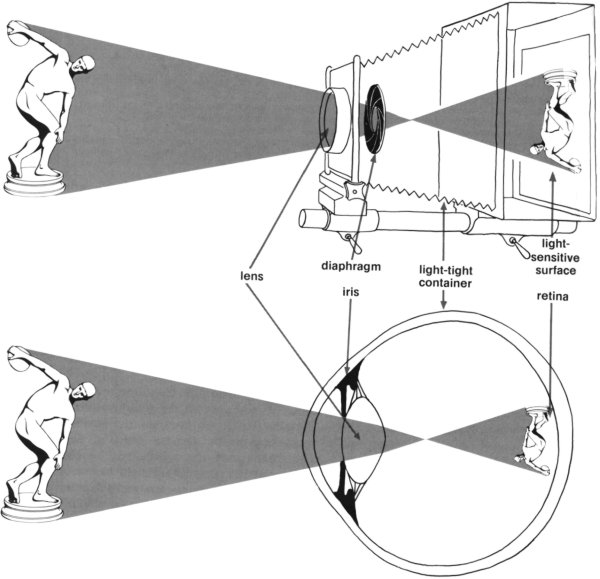
The brain then re-orients, while the camera uses mirrors. All this has to do with being able to visualize objects larger than the eye. As described by retinaeyedoctor.com in speaking of their own prepresentative chart:
By reversing the image, we are able to visualize objects much larger than our eye. If you look at the light rays, colored in blue (see above), you will notice that the distance between the light rays emanating from the top and the bottom of the chart get closer together as they approach the eye. At some point, they actually cross and reverse. The image of the eye chart is getting smaller, too. The light rays get smaller allowing the entire image to fit through the pupil and form a complete image on the retina, albeit upside down and reversed. Without this reversal, we would have a very limited view of our world. It would be similar to viewing the world through a drinking straw.
Relatively speaking, things are upside down and left is right and right is left. A camera fixes this with a mirror and a five sided penta-prism that deviates a beam of light by a contant 90 degrees. The beam reflects within the prism twice so that one has transmission of the image through a right angle with no inversion as would be had with a right-angle prism or mirror. Wikipedia provides the following example:
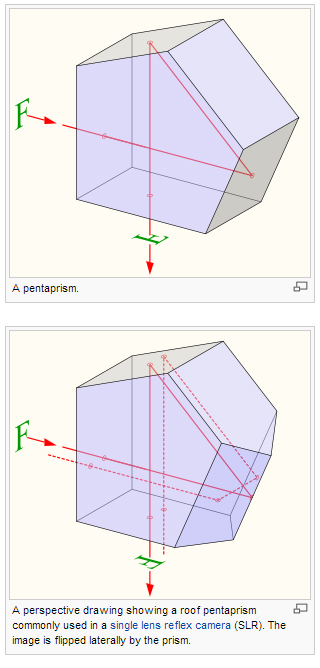
One can imagine how all this might be attractive food for thought for a photographer such as Kubrick. And the above diagram of the pentaprim reminds me very much of the cockpit in the Discovery One and some peculiarities of perception had in it.
The brain fixes this with a cross-over of nerves called the Optic chiasm. Plus it just plain adapts. A man named George Stratton experimented with wearing glasses that inverted images upside-down and left-right and adapted within a few days. When the glasses were removed he would use his left hand when he should have used his right, but again he quickly adapted back. He also did a 90 degrees shift experiment via mirrors and again he adapated. Stratton was a philosopher, he worked with perception and psychology, and, as a dualist, attempted to construct a psychology of religious life as a means of coping with conceptual opposites.
The below is from Richard L. Gregory's Medawar Lecture 2001 Knowledge for vision: vision for knowledge, and it seems a good thing to insert at this point, respecting the differences between perceptual knowledge rather than concenptual knowledge:
Visual science may not always recognize the importance of knowledge for giving significance to vision, as its origins in Greek philosophy set ways of thinking before images were discovered in eyes. Retinal images were hardly appreciated before Descartes and Kepler early in the seventeenth century (Wade 1998). The later notion of the senses as transducers, signalling to the brain with slowly travelling neural activity, was hardly appreciated before Hermann von Helmholtz in the middle of the nineteenth century. Then, it became clear that physiological channels separated perception and experience from the object world, though the implications are not always recognized.
Before these key discoveries, it was generally supposed that vision was directly related to objects of the external world, either by 'fingers' of light shooting out and touching objects, or by objects sending expanding 'simulacra' of themselves to the observer (Ronchi 1957/1991). This tradition of perception, as directly related to the world of objects, has not altogether died (Gibson 1950, 1966, and followers). Yet, the most striking fact is that perceptual experience is far richer than available retinal images; and though neural signalling is slow, it is not usually delayed in time. From these shadowy ghosts in our eyes we see hard solid objects with properties beyond optics. This depends on knowledge of objects, and how they interact, allowing behaviour to be appropriate to what is known or assumed, rather than limited to what is being sensed. This is where knowledge comes in, as the past enriches the present, and allows some prediction into the future.
This is 'perceptual' knowledge of object properties, rather than 'conceptual' knowledge, which may be abstract and far removed from perceptual experience. Perceptual and conceptual knowledge can be very different, and may disagree.
Kubrick's films are like exercises in inattentional blindnesss and change blindness (which is different from inattentional blindness).
Simons and Chabris attribute this failure to detect an ongoing and highly salient, yet unexpected event to inattentiveness or 'divided attention'. Since ancient times the phenomenon itself has been used--and misused--by illusionists, stage magicians, and tricksters. In the medico-psychological literature it has been described at least since the era of mesmerism...It has been suggested that, in a conceptual and phenomenological sense, inattentional blindness may well be similar to hypnotic blindness.
A Dictionary of Hallucinations by Jan Dirk Blom
tl;dr. What happened, other than Poole being killed by HAL and HAL going crazy? HAL is such a great villain!
Stop now. You will not want to read about how Poole goes flying off to the left of the Discovery One yet Bowman pursues him to the right of the Discovery One, and how this is not an error and is important and has been prefigured in the first three sections by all the previous reversals Kubrick has thrown in and the chess game with HAL.
June 2014. Approx 15,100 words or 31 single-spaced pages. A 118 minute read at 130 wpm.
Return to the top of the page.
Next: Part five
Return to Table of Contents for "2001: A Space Odyssey" analysis
Link to the main film page for all the analyses

